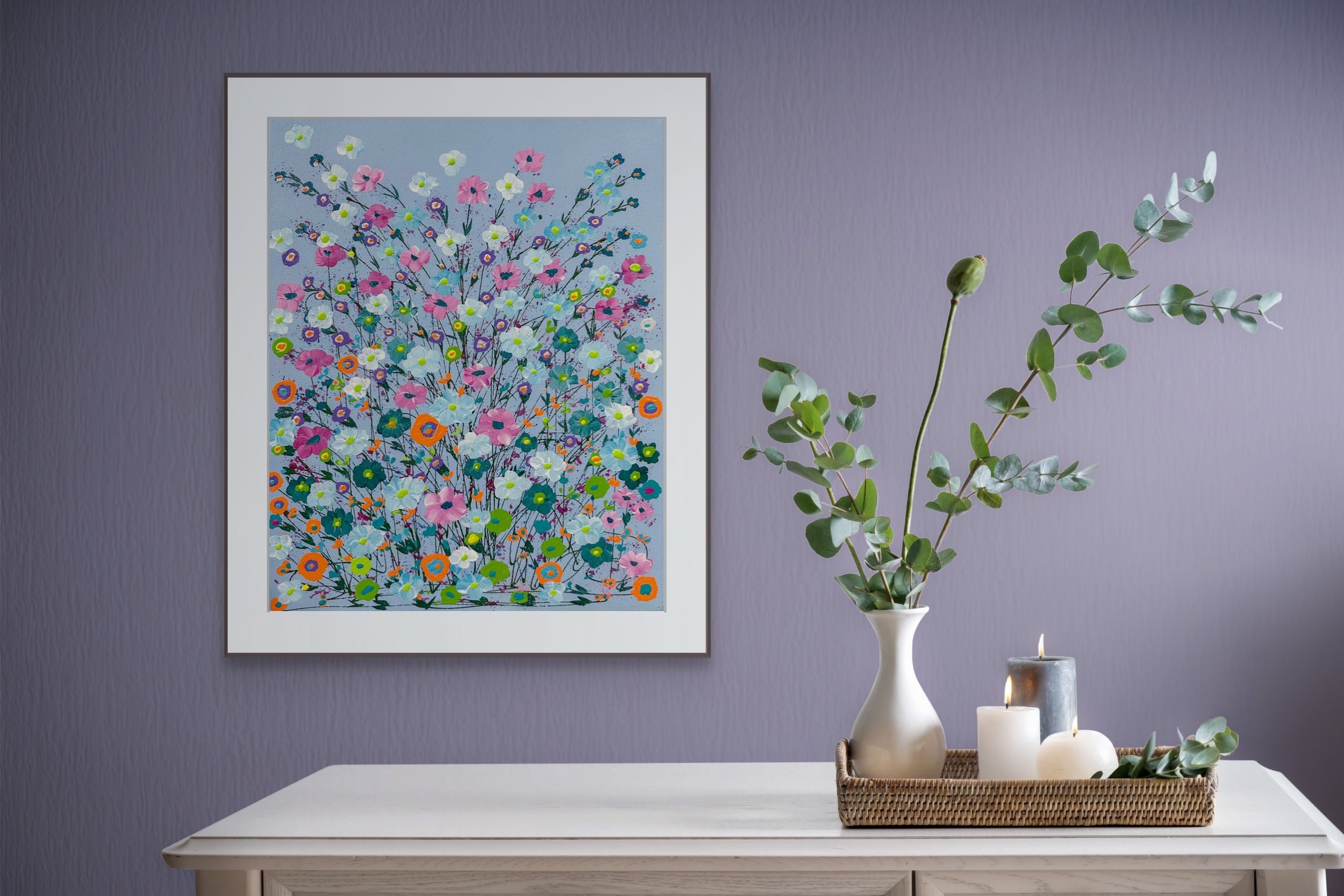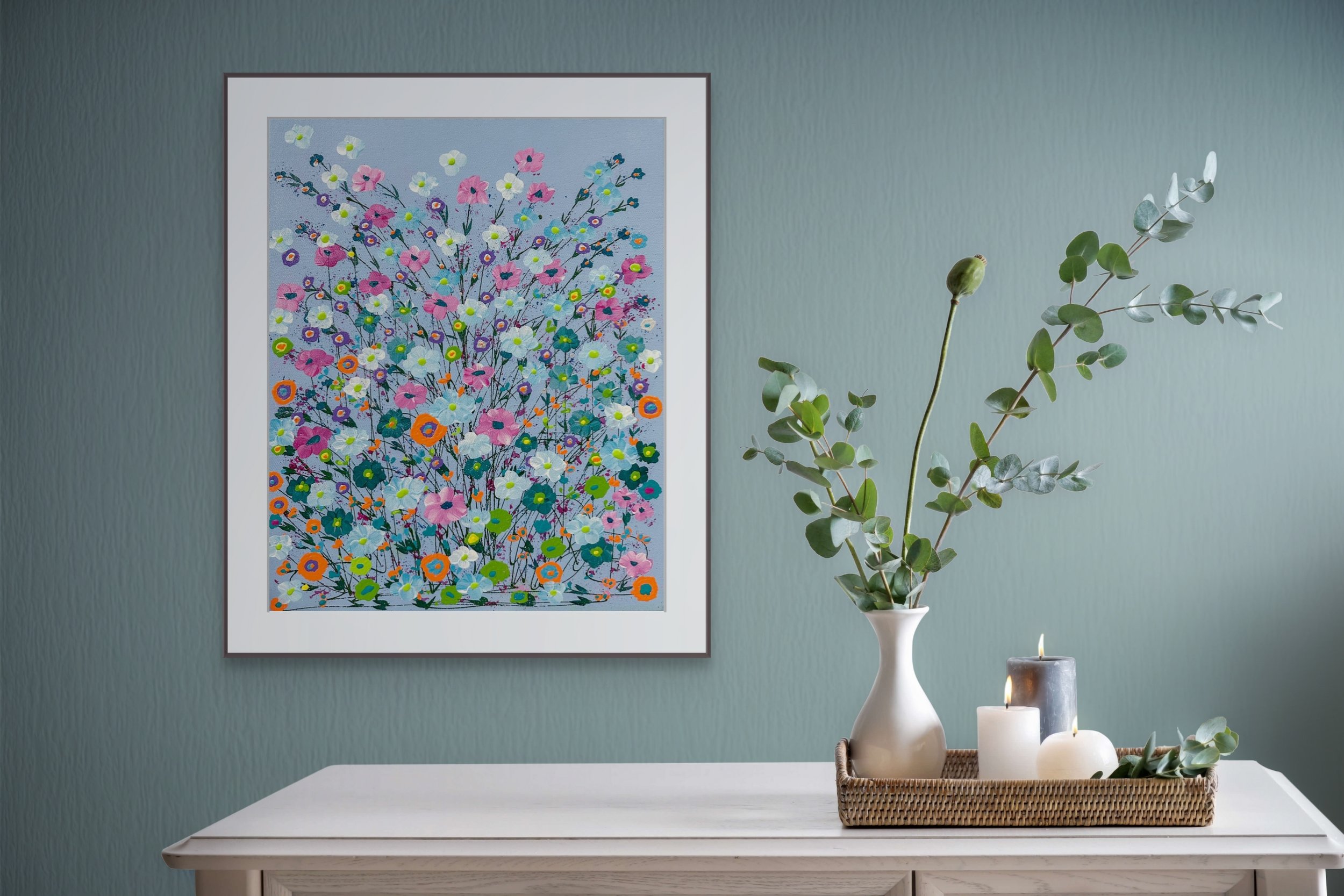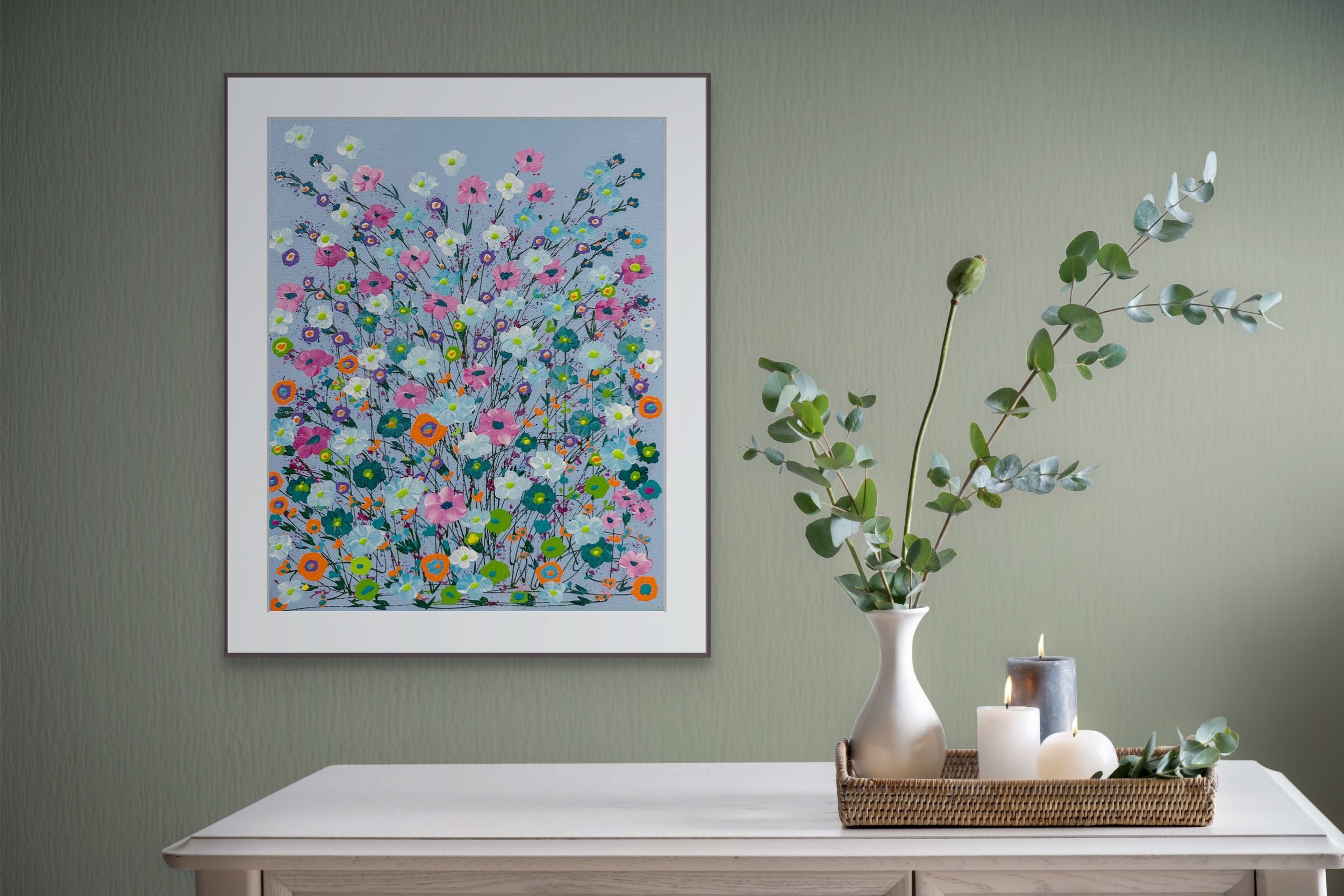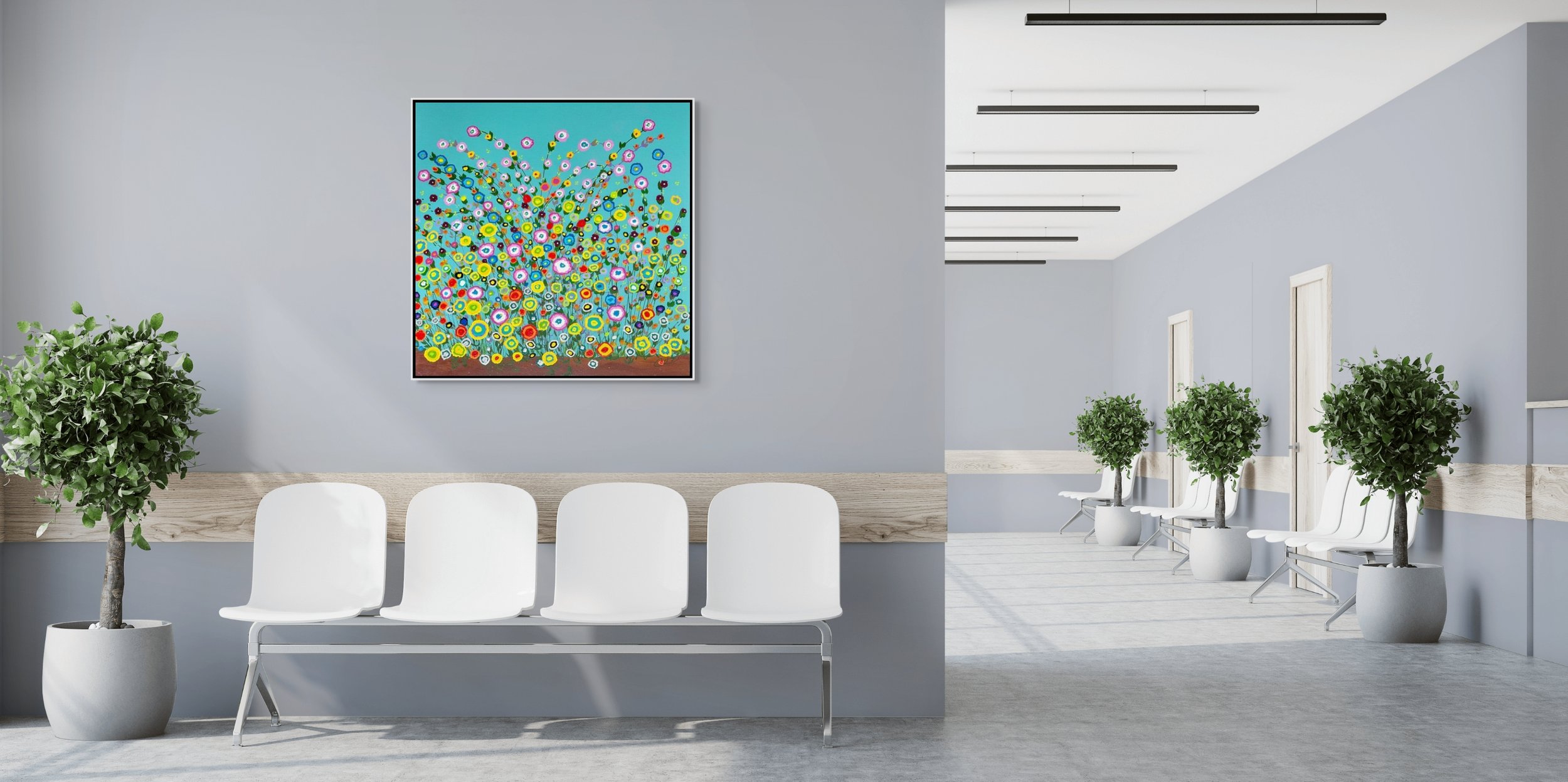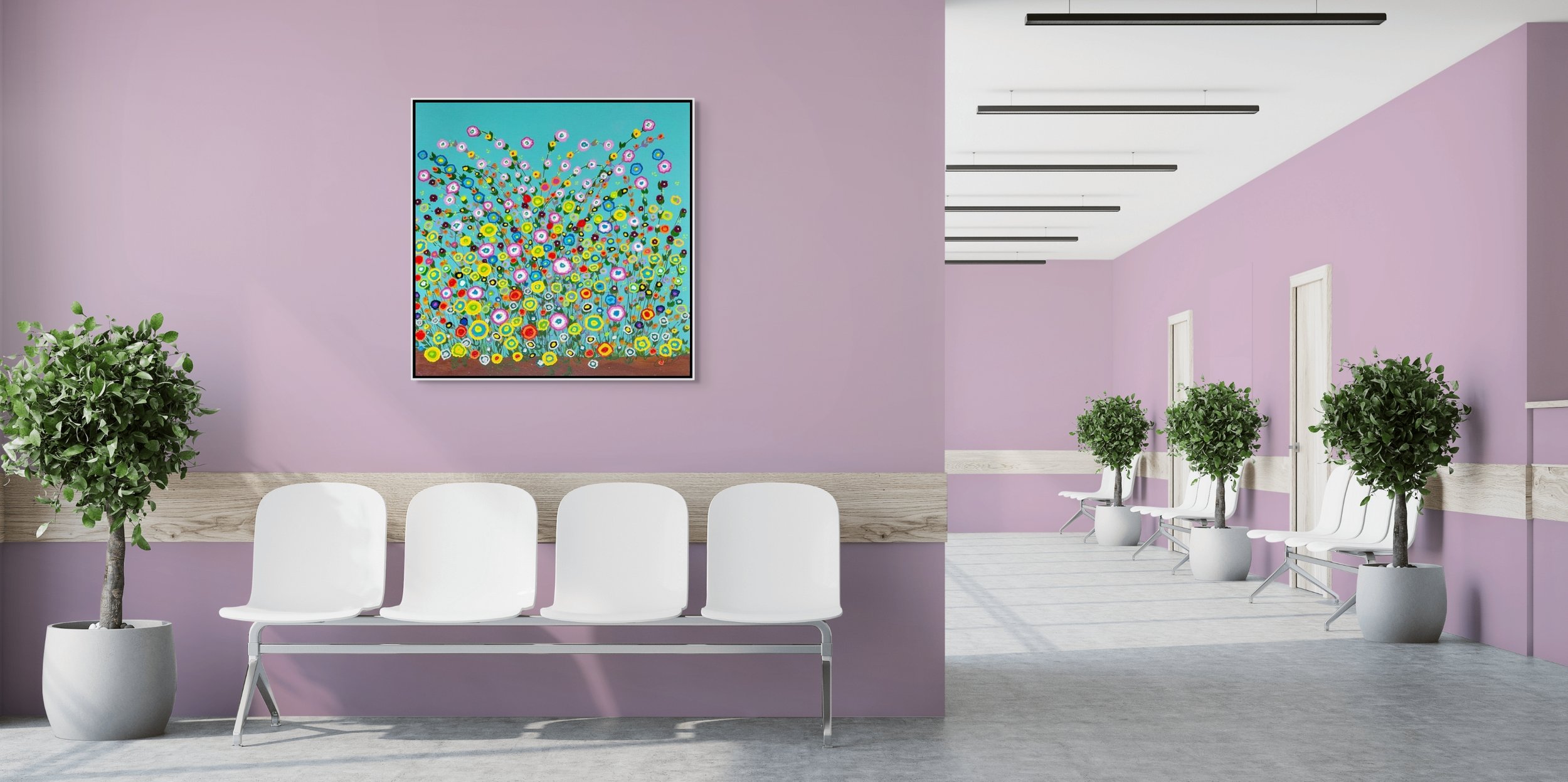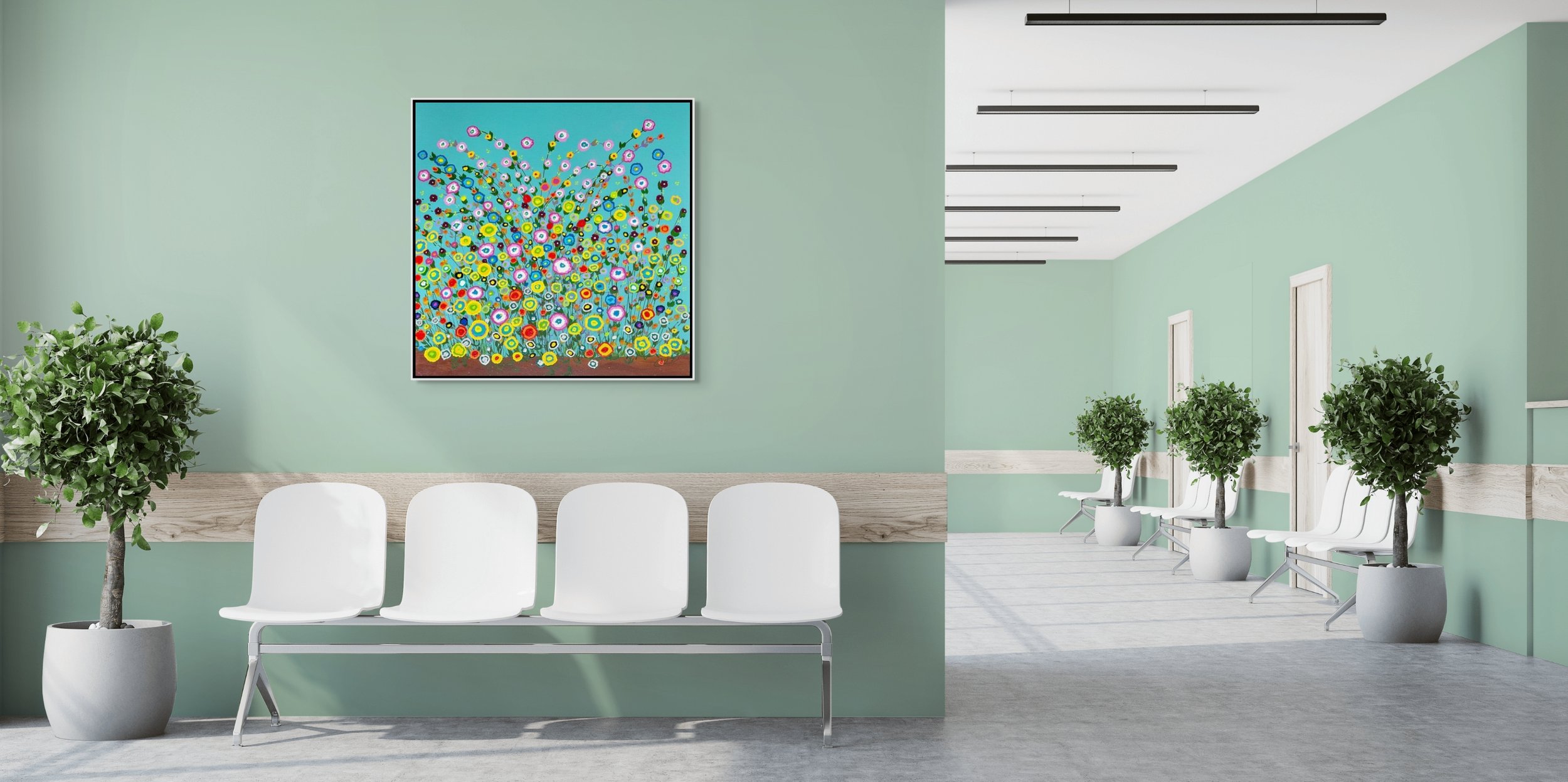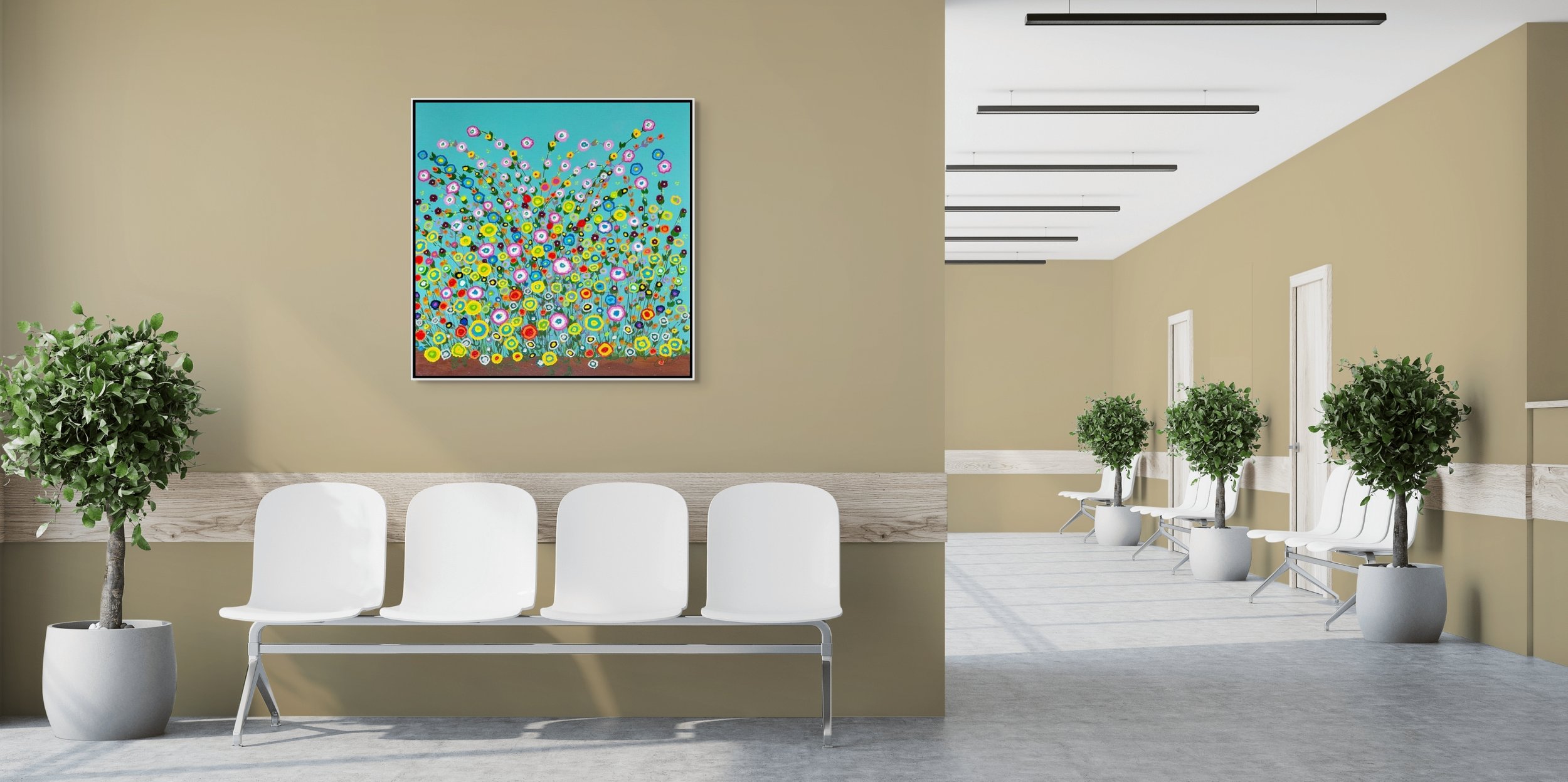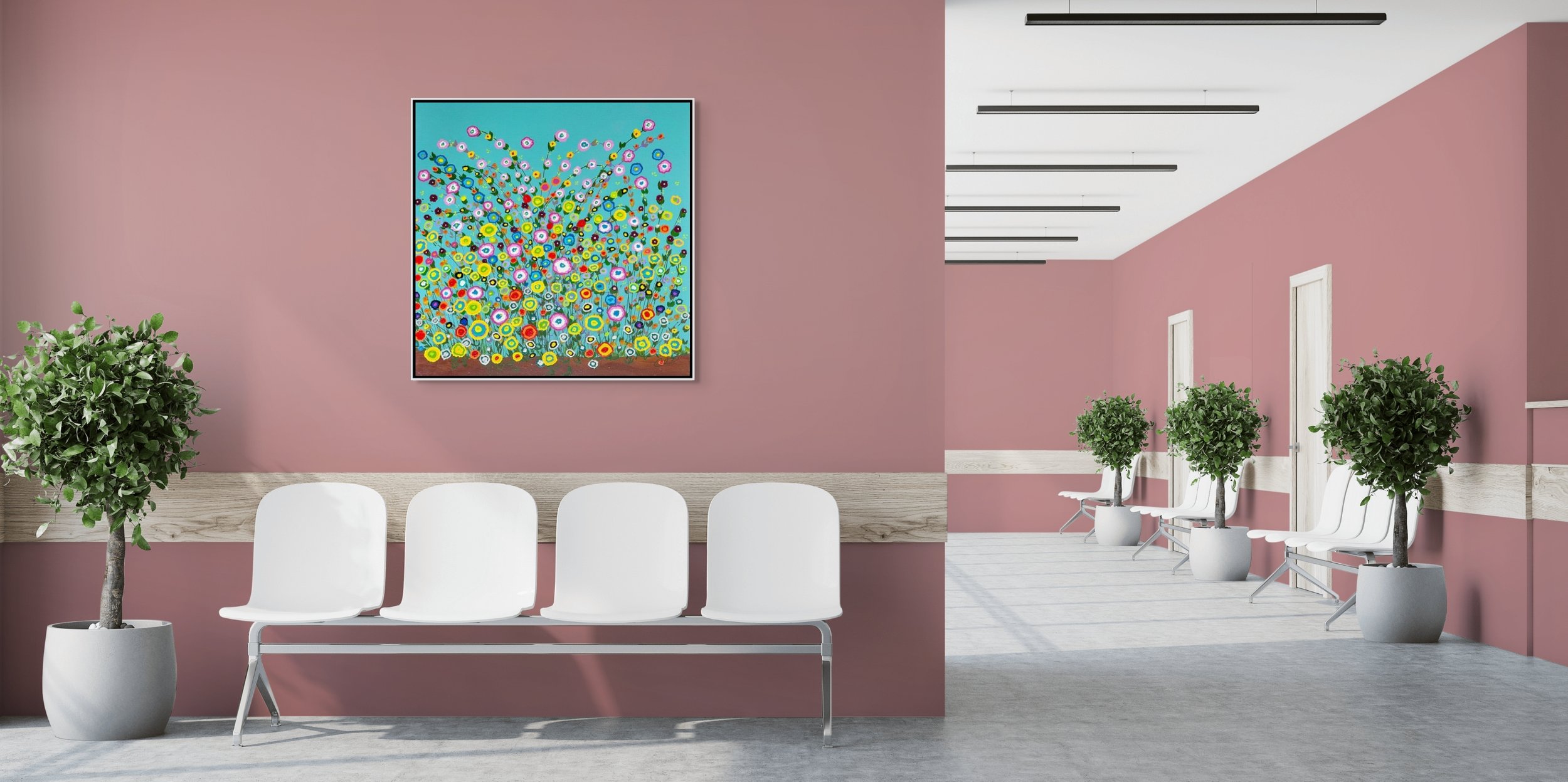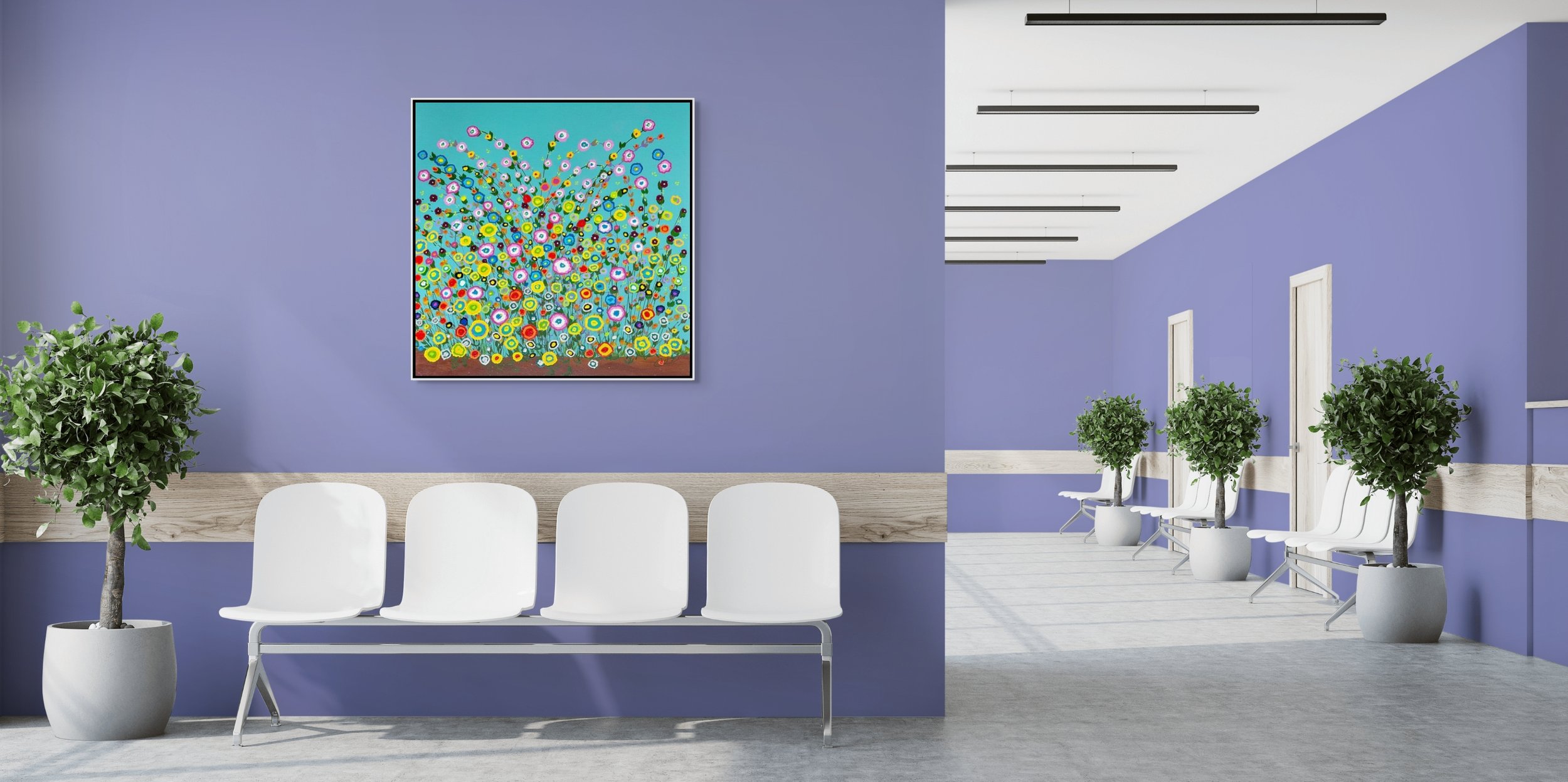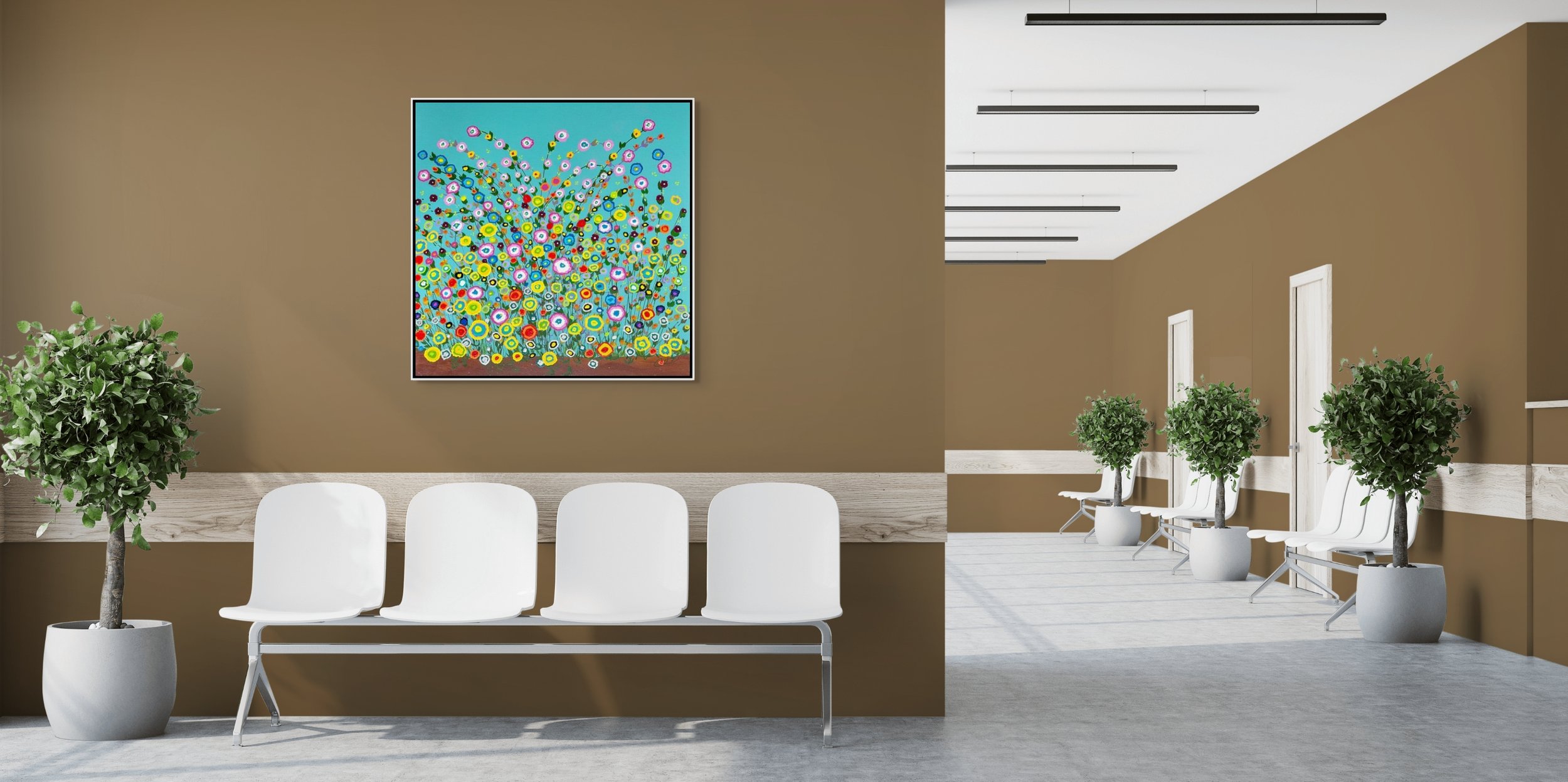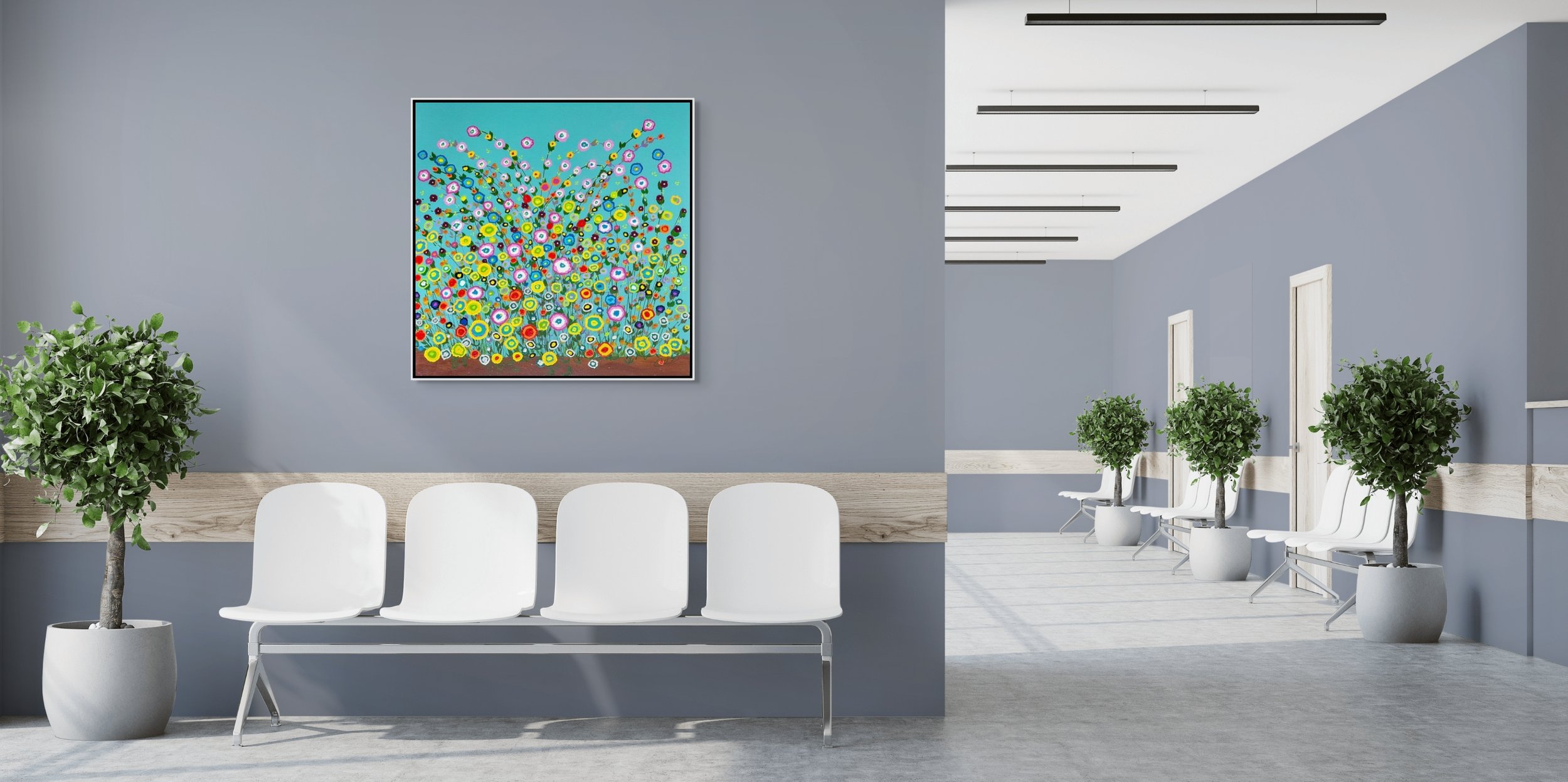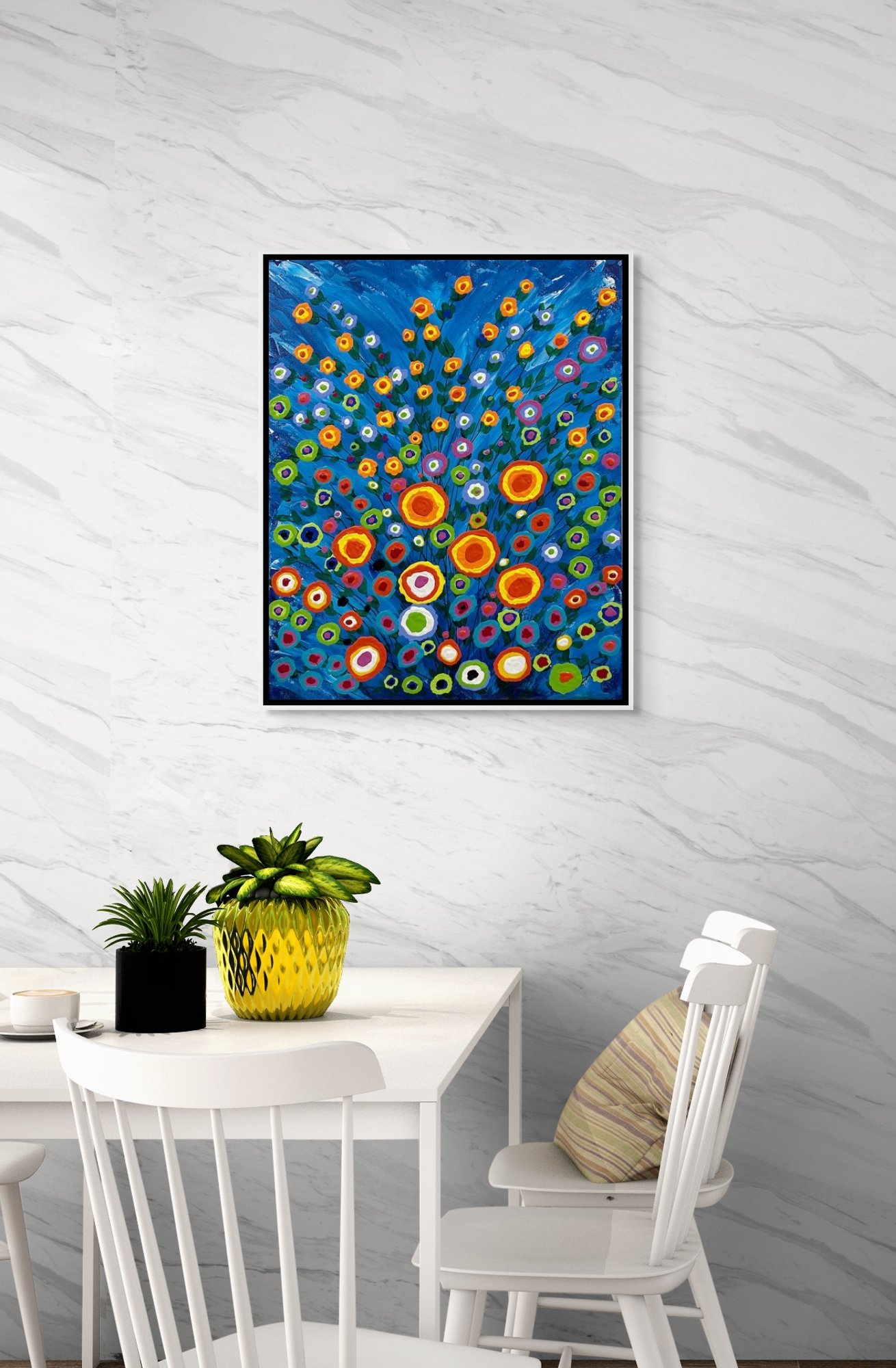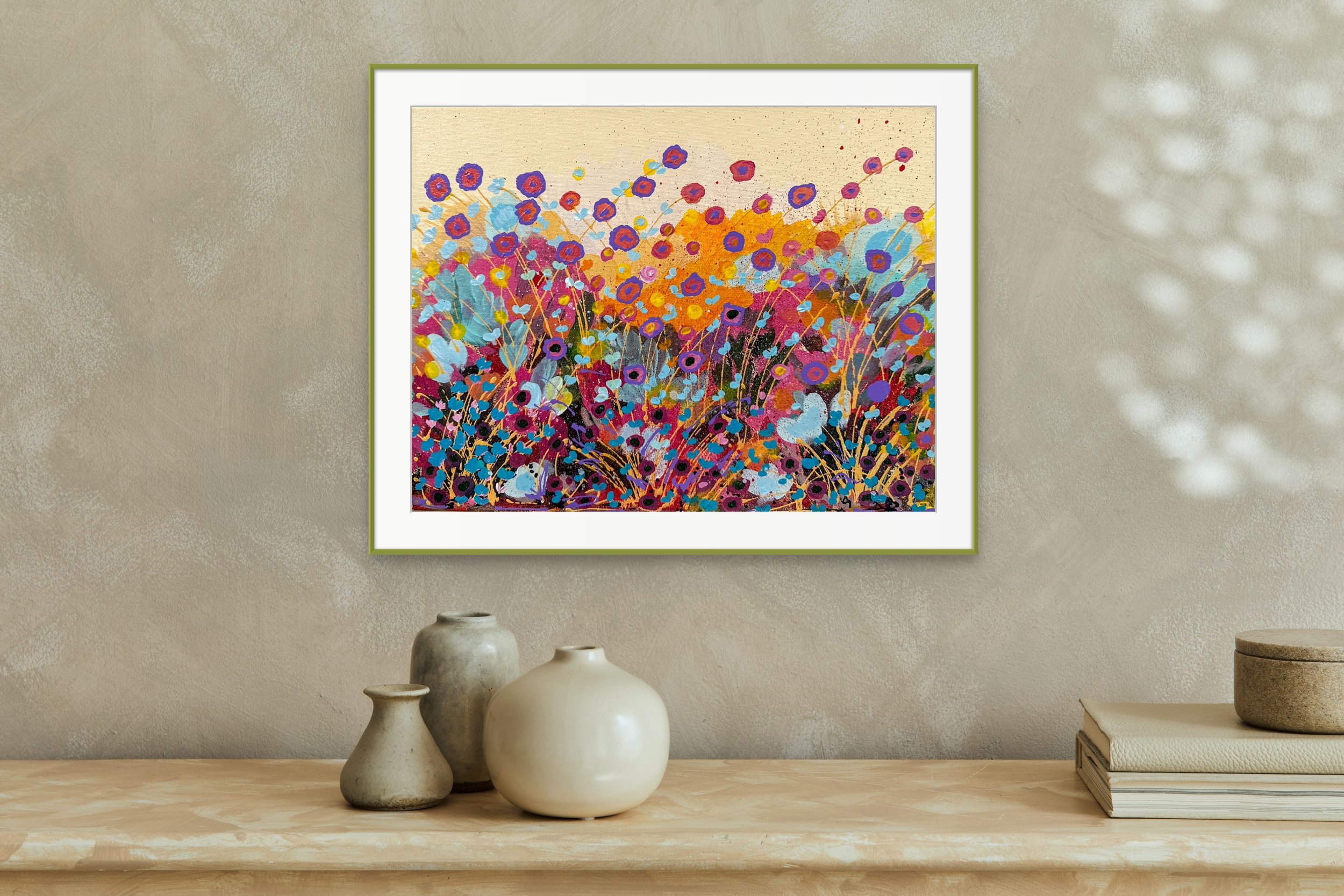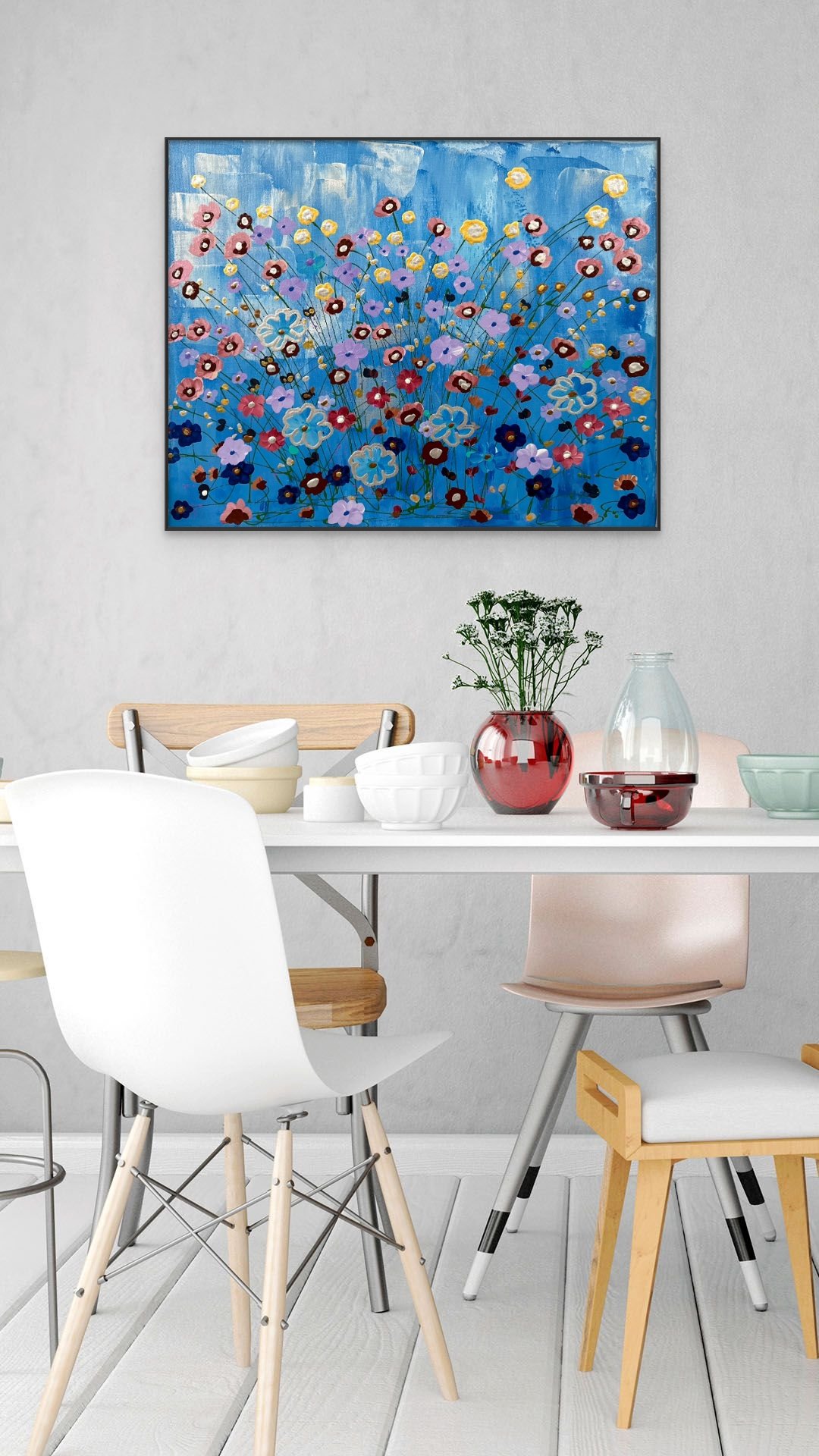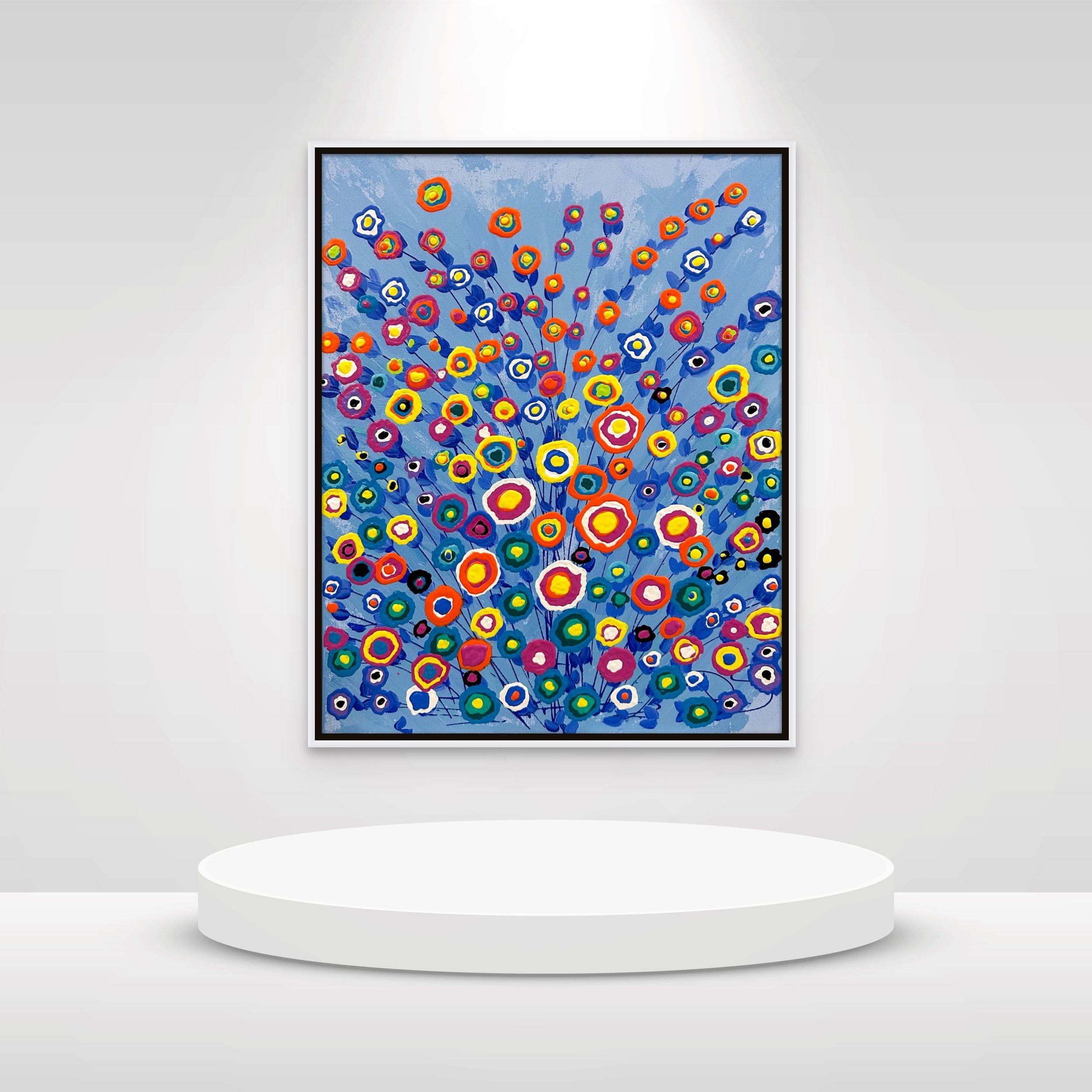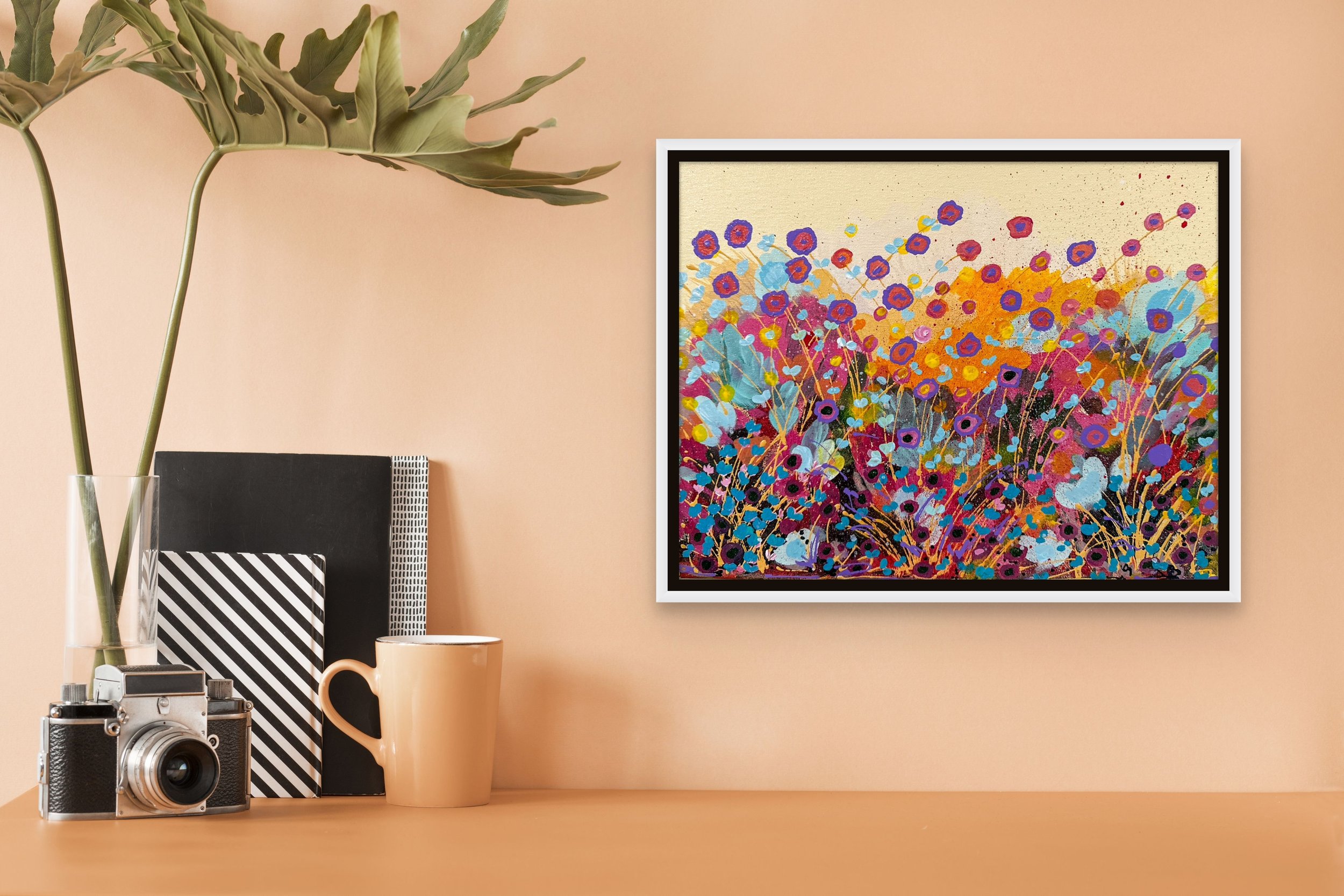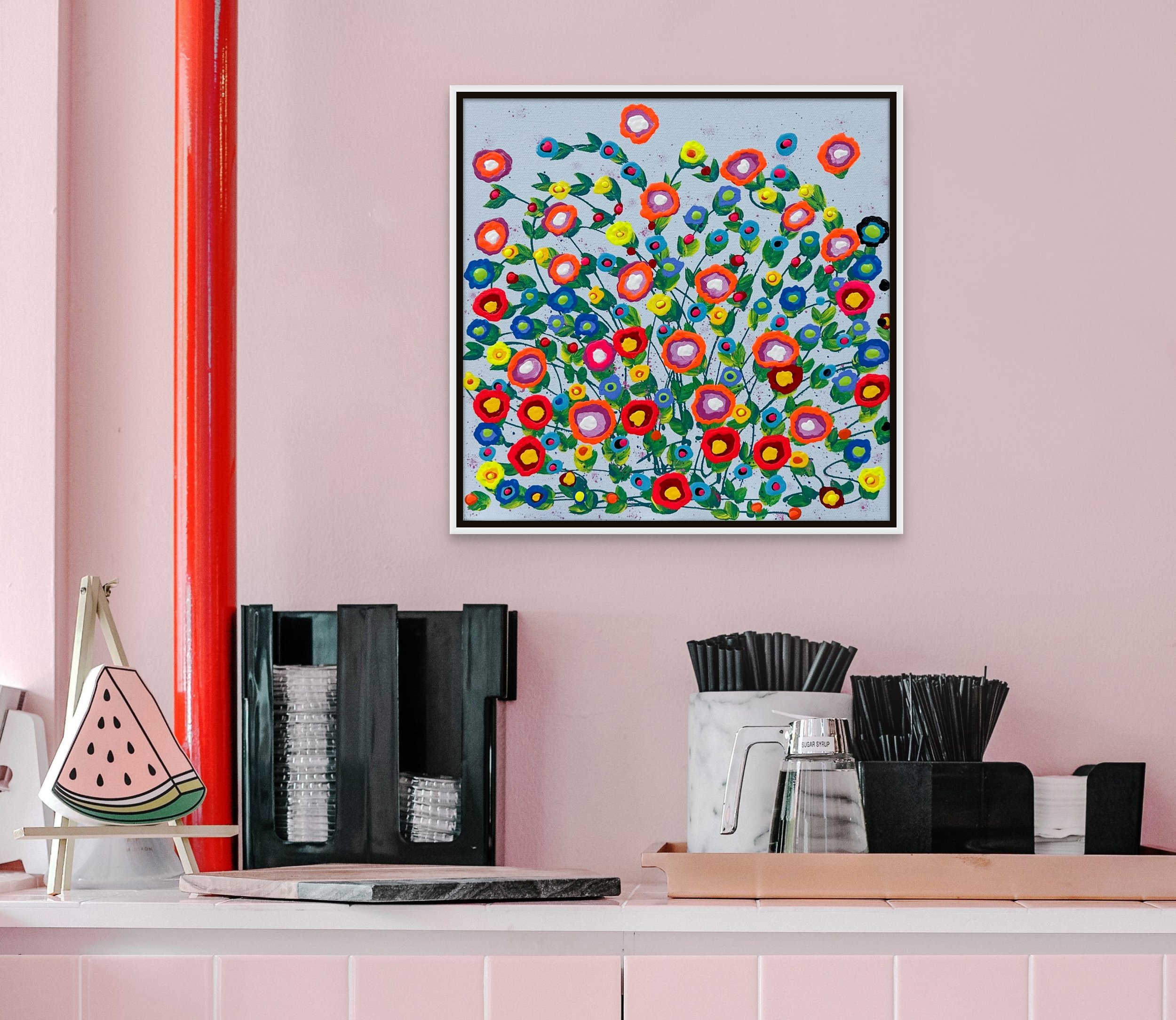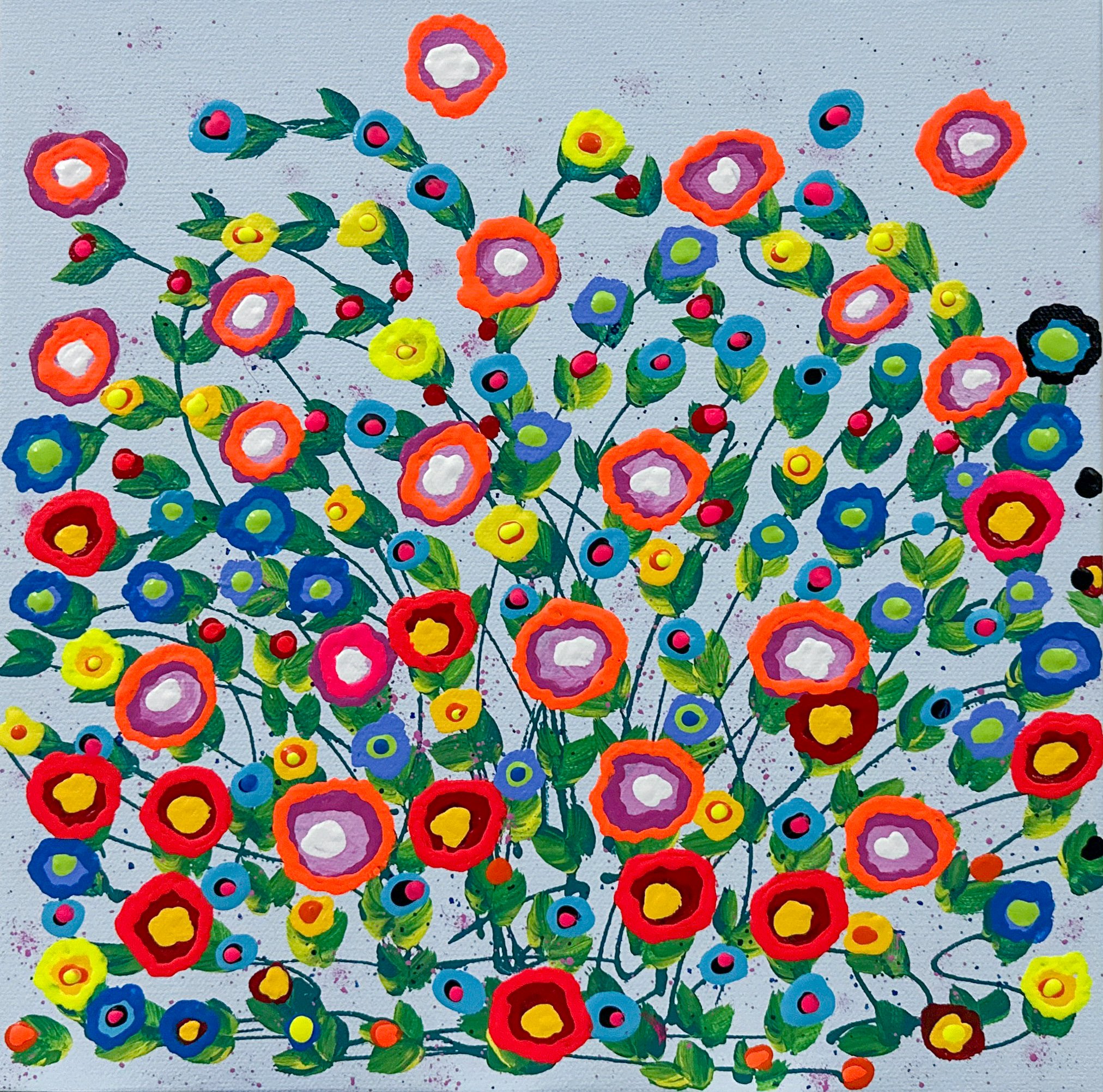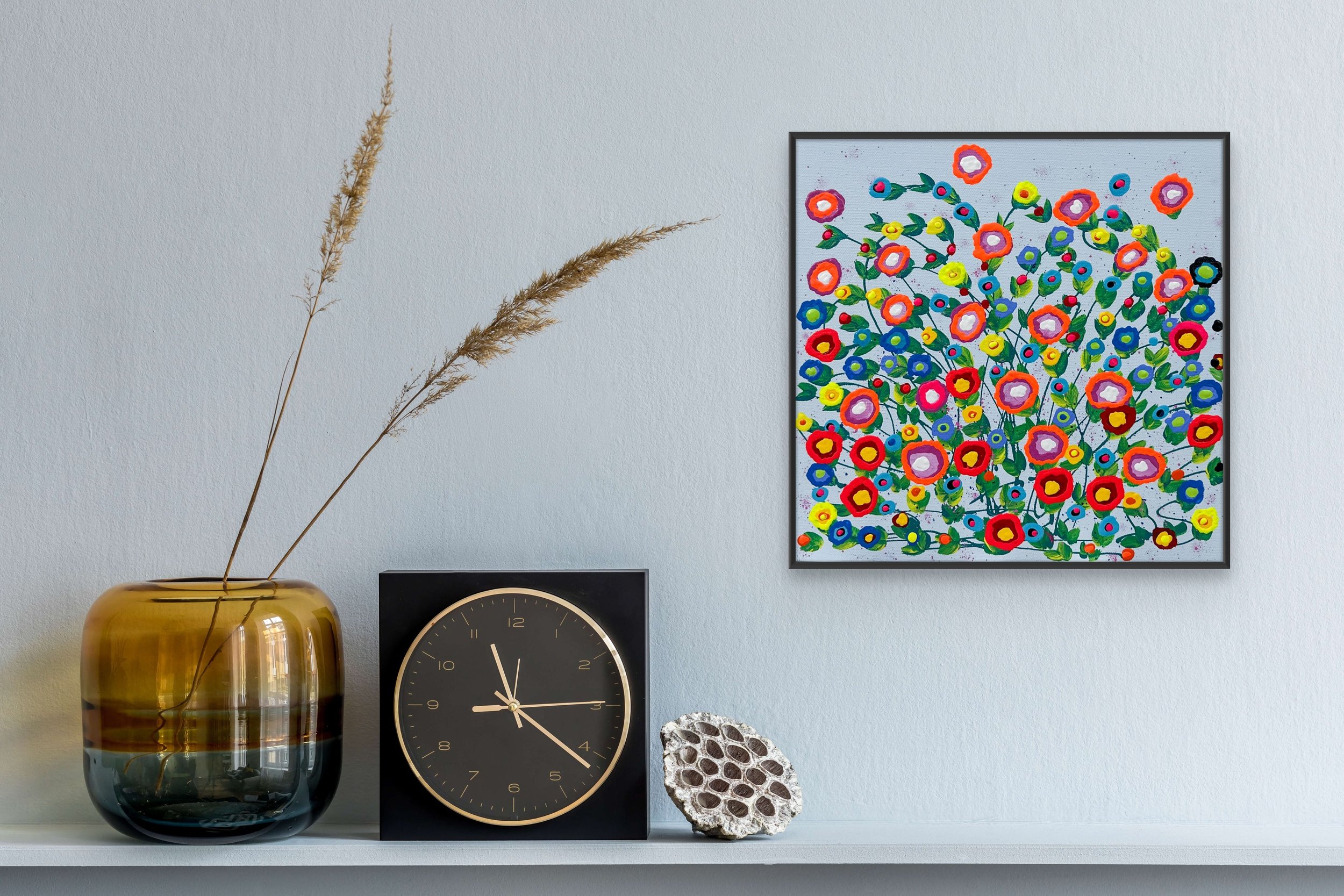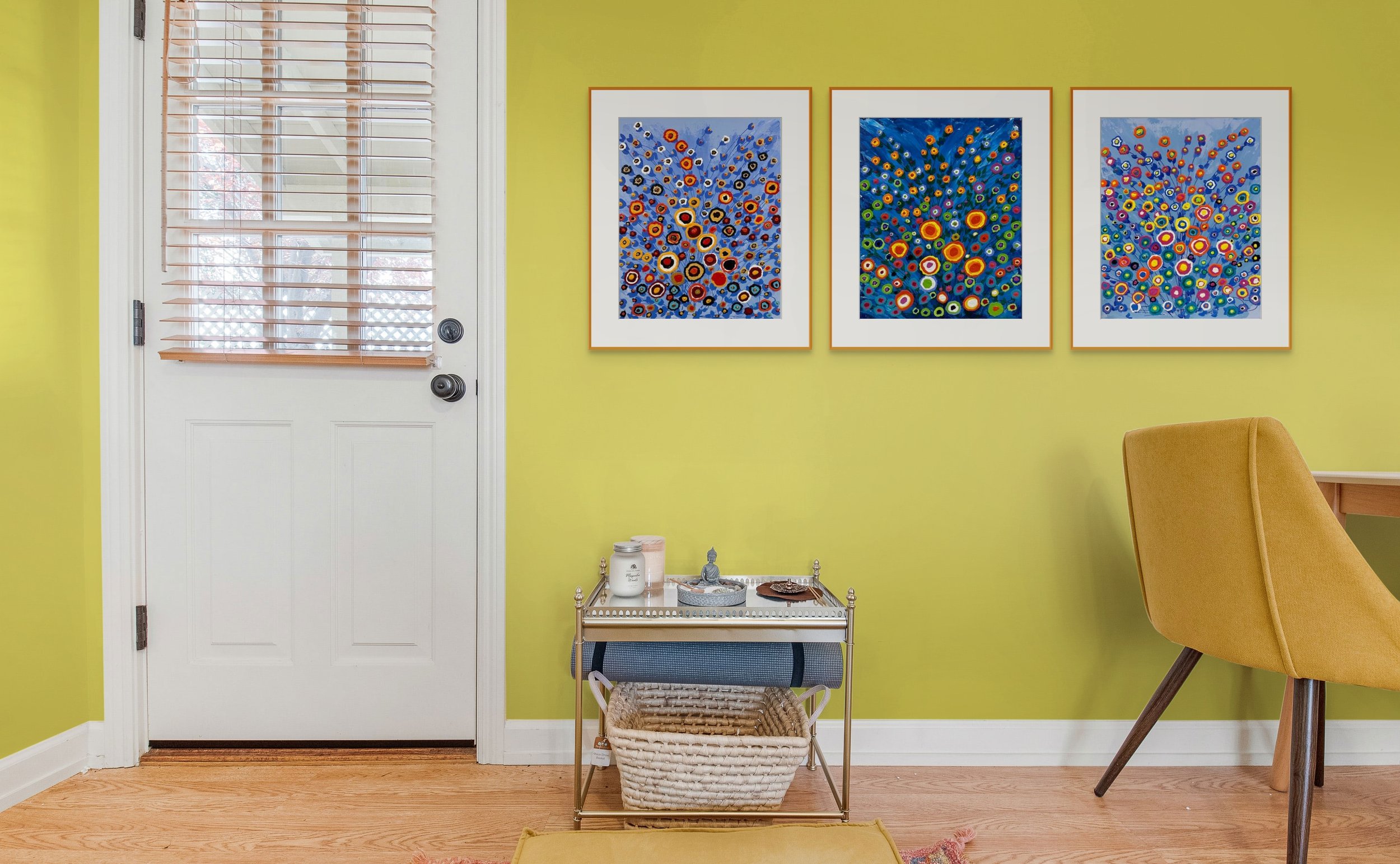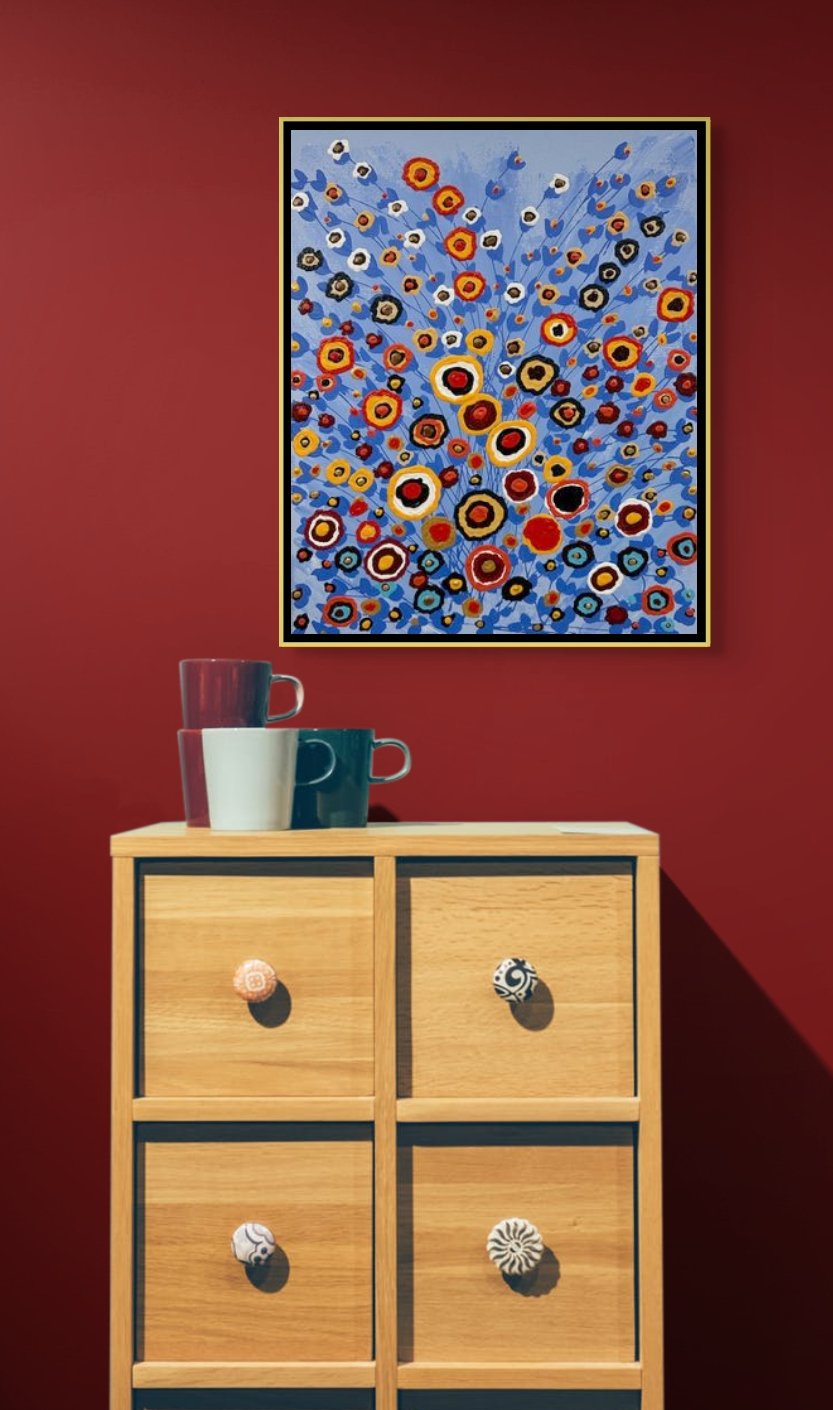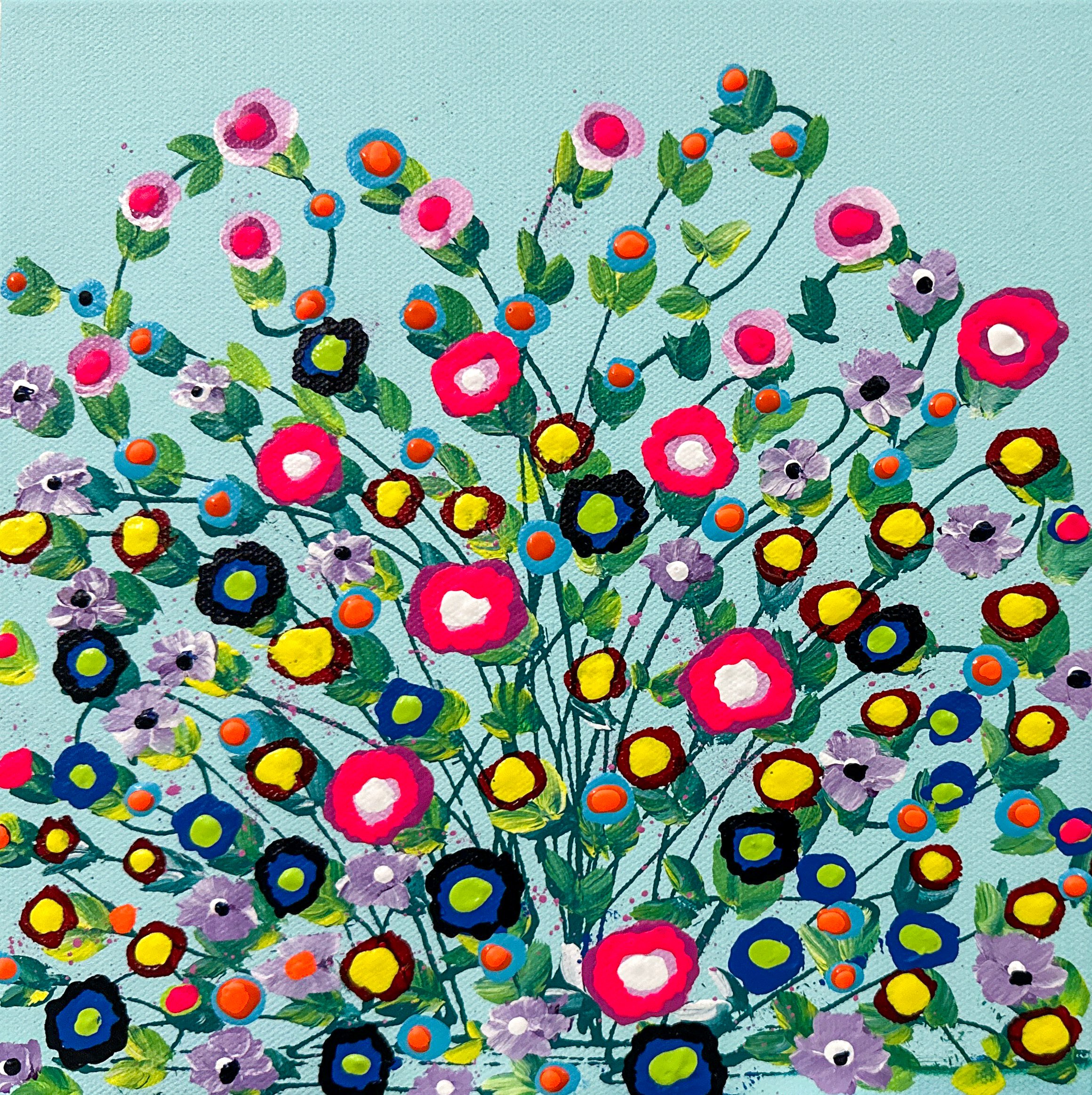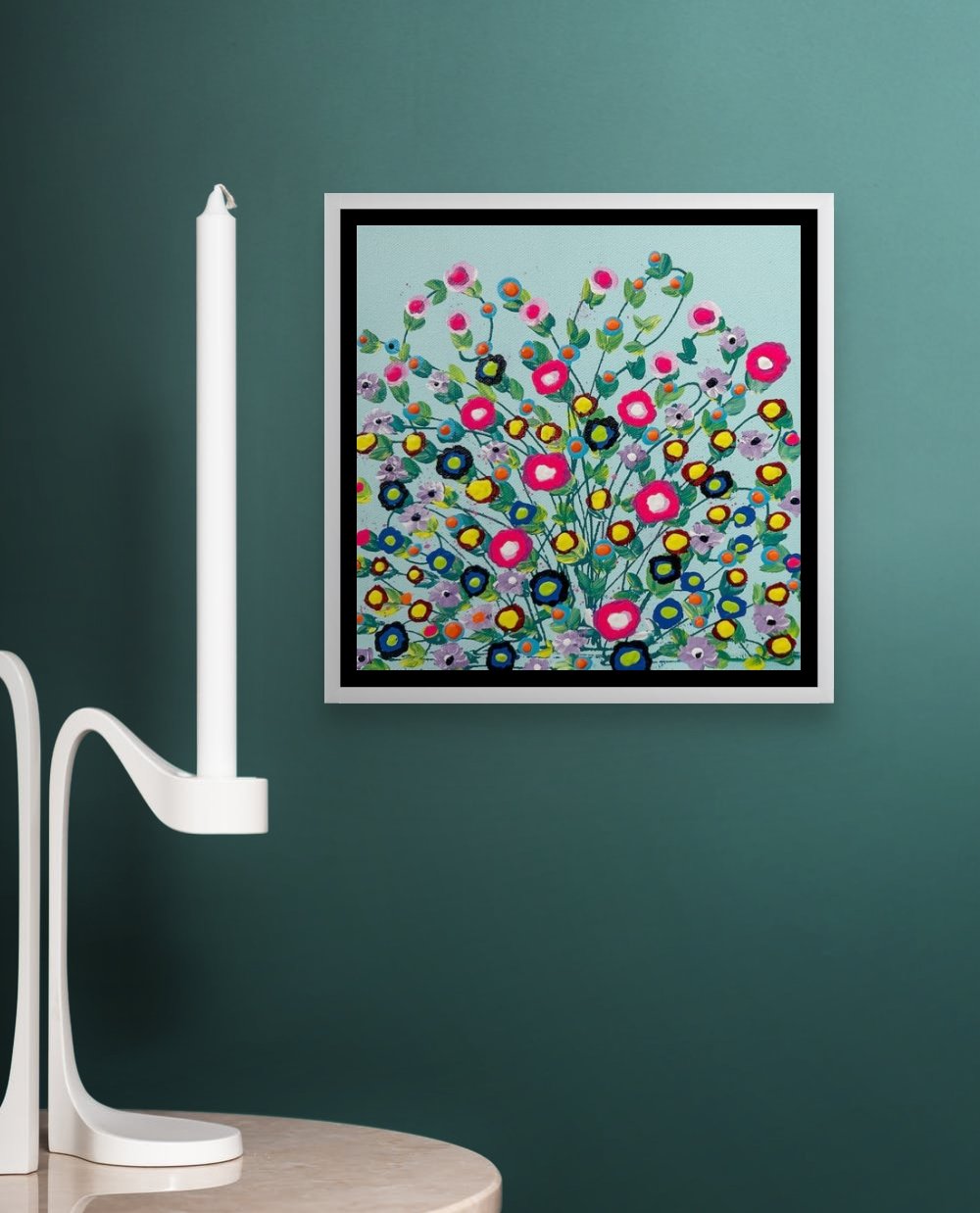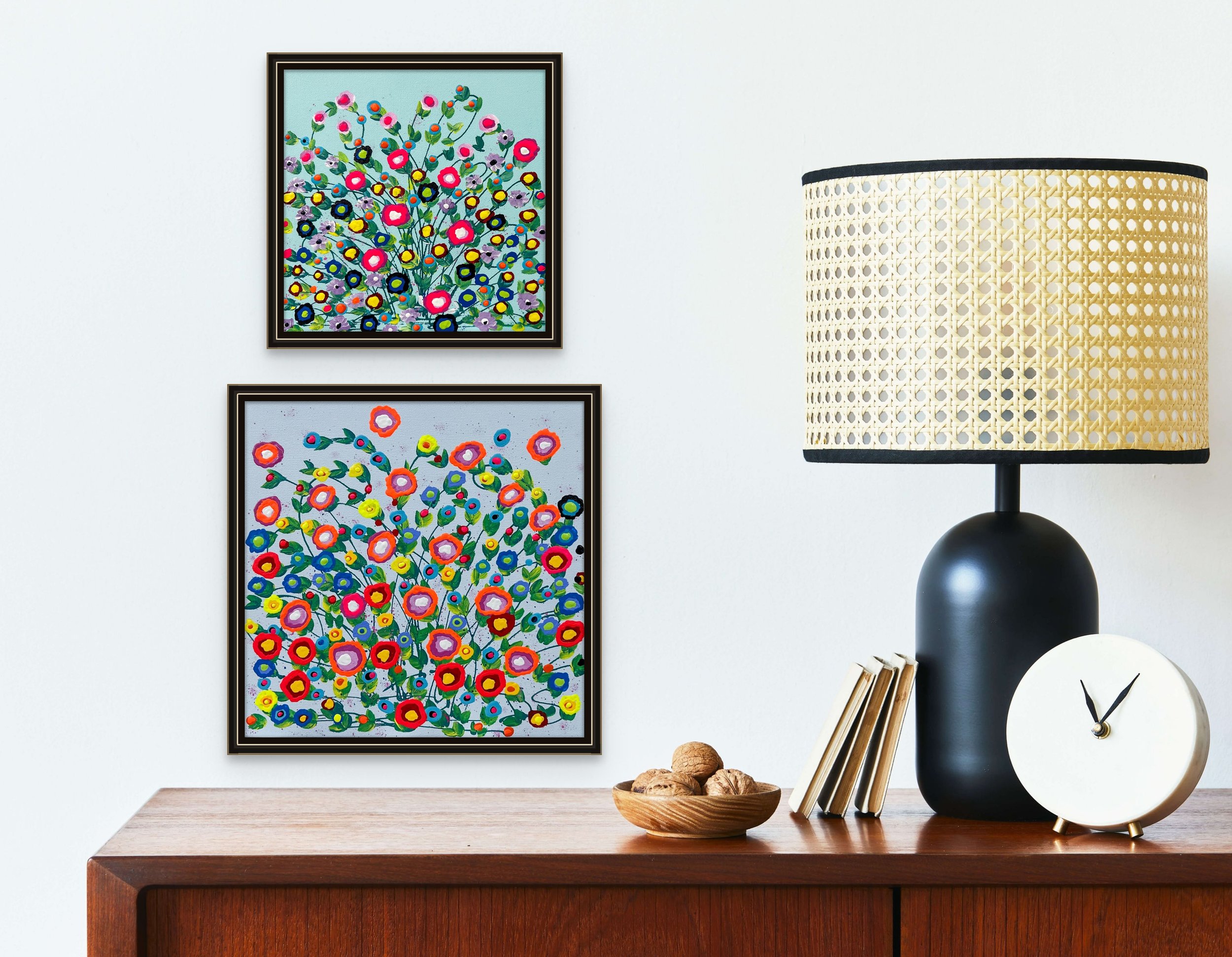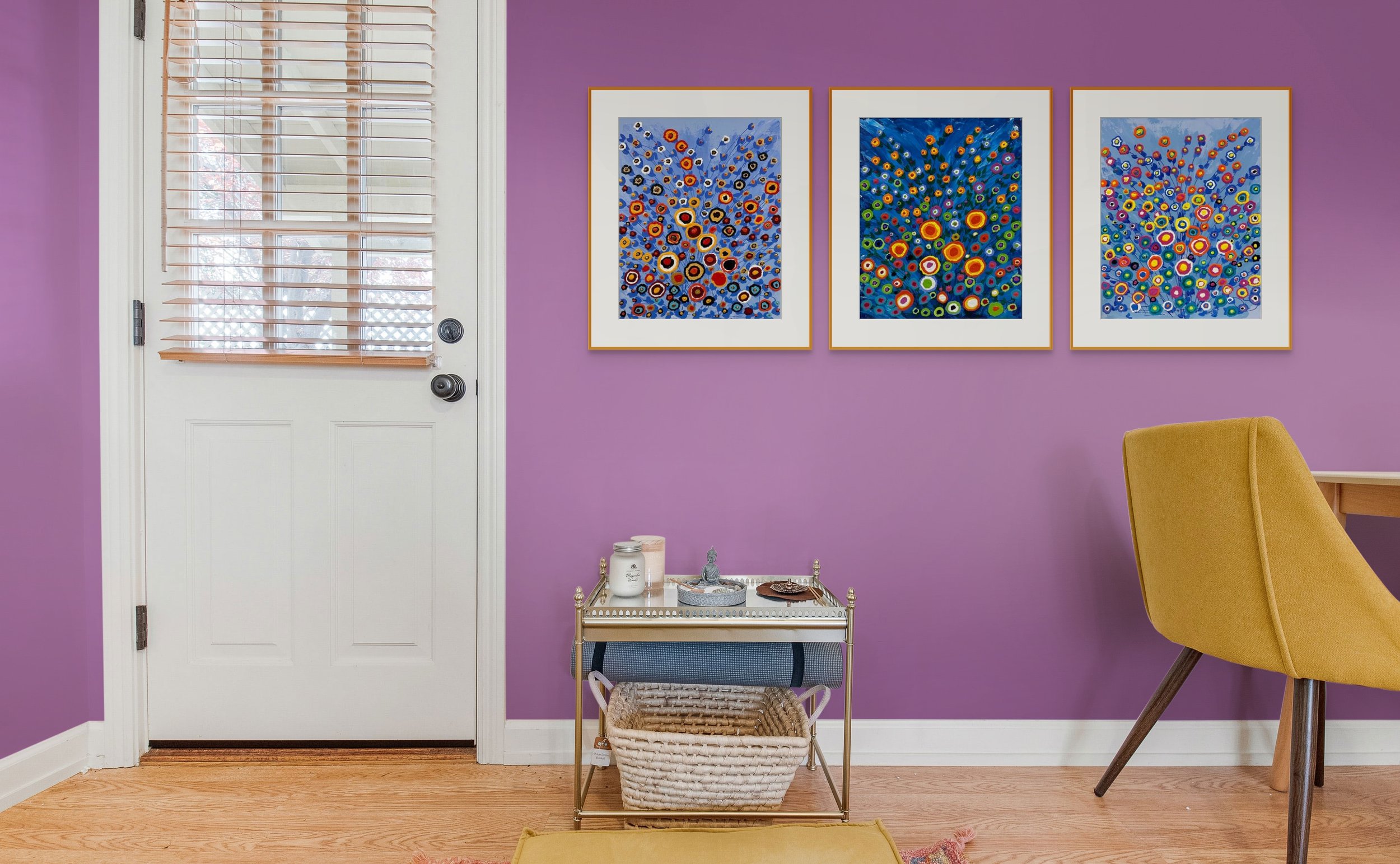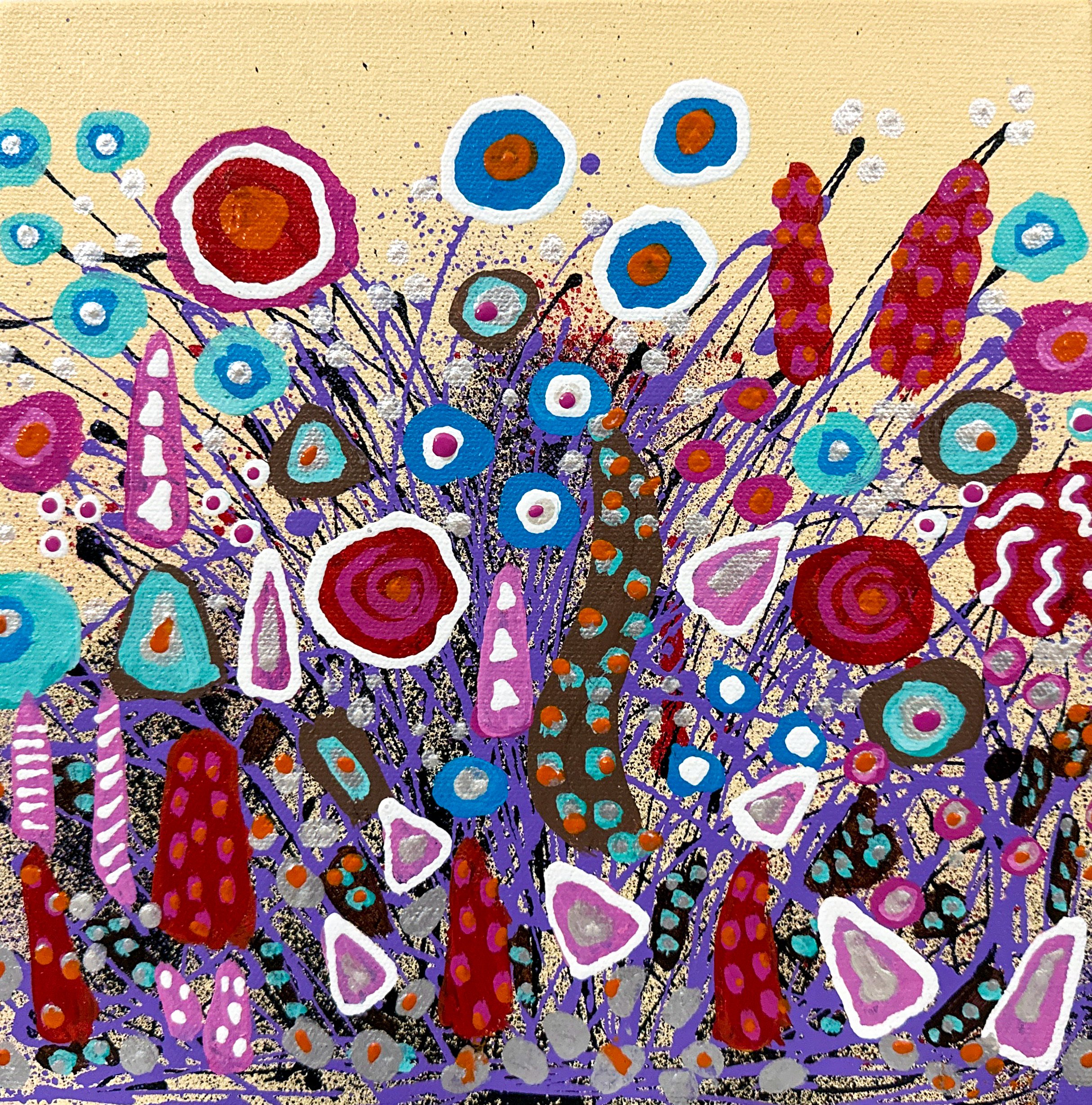Scientists, Researchers, And Art
I get told—all the time—how my art is beautiful and how happy it makes people feel. This is true, but there’s a deeper story here.
Hidden away from the public, and often in research labs and scientific facilities, are the many people who have dedicated themselves to the study of human health and happiness. They are doctors, researchers, scientists, and more, and I like to read their research results and then transition what I have read into a work of art.
I don’t mind taking credit for being a talented artist, but I never forget all the hours and days and years of intelligent scientific thought and methodology that went into the medical and scientific study results that I read and then use inside my art.
I also like to experiment. Here’s my latest painting using many evidence (research)-based design strategies and suggestions.
In evidence-based design and art, local scenery is often suggested. Instead of focusing on a snapshot of a local scene, I chose to take in an entire journey within a local area and represent it through art.
This painting was inspired by nature and a trip I took from Pasadena, California, along the super busy Foothill Freeway on my way into the desert area near Palm Springs.
To be exact, in Pasadena, I got on the 210 Foothill Freeway, with the thickly wooded and dark green San Bernardino Forest on my left. As the highway transitioned to US Interstate 10, it started raining, and suddenly, 10 lanes of headlights came on. It was bumper-to-bumper and stop-and-go traffic for a while, and then the rain stopped and the traffic eased up as I entered the California desert area. Still on Interstate 10, I could see Mt. San Jacinto and then the Santa Rosa and San Jacinto mountains in the distance.
In this painting, I chose the cheerful colors of yellow, muted pink, and orange to represent the mountains.
There is an abundance of sand in the desert, so I used Liquitex’s professional-level unbleached titanium/beige (with a touch of gold) color for the painting’s sky and background.
In evidence-based design, you don’t have to represent everything realistically: for example, you don't always have to create a blue sky.
Every two years, the Center for Health Design requires its certified members to take additional evidence-based design courses in order to recertify. This year, one of my selected CEU courses was The Changemaker-A Pioneer Connecting Art, Medicine, and the Advancement of Evidence-based Design. This course was about Dr. Henry Domke, a physician and photographer. For over 20 years, Dr. Domke practiced as a family physician, which gave him firsthand insight into the stress and anxiety experienced by patients and their families in medical facilities. His healing intent is to use art to create a "healing tone" that provides comfort, reduces stress, and offers positive distractions for patients, staff, and visitors.
Something he said in the video—and I agree with and use all the time in my art—is that an evidence-based design’s composition and focus should not be about the artist. When I paint, it’s not about my ego or my self-glorification. An evidence-based design composition should be created with the patient's needs in mind.
Happy Sustainable Melodies was created as a fun, almost whimsical work of art that reflects a local scenery adventure. With its bright, happy colors, playful stem arrangements, and splashes of green impressionist flowers, it’s also a happy distraction piece.
The brilliant blue color was used to represent a gap between leaving the 210 Foothill Freeway, with its deeper dark colors and thickly populated area, and entering the openness of the desert.
The darkness at the bottom of the painting represents beginning this artistic local scenery journey at the deep-colored and green San Bernardino Forest area. The many plant stems going in many winding and different directions reflect the lanes and lanes of traffic coming in and out, as I traveled on these highways. Midway in the painting, the various colors leading to the desert area show how the scenery transitions from one type of landscape to another.
For people/patients who know the area, this painting—in a fun and happy abstract/expressionism/impressionism style—reassures and comforts and recenters them by visually connecting them to their nature-filled and sustainable beautiful local scenery.
And most importantly, this painting never would have been created this way—at least not by me—without all the hard work and loving dedication of doctors, researchers, scientists, and more.
More Evidence-Based Design Guidelines
There’s Evidence-based Design, and then there’s NOT Evidence-based Design.
Here are more evidence-based design art guidelines. Many of these guidelines come from “A Guide to Evidence-based Art” from The Center For Health Design, research by Ulrich and Gilpin, a case study on best practices in evidence-based design by the Mays Clinic at the MD Anderson Cancer Center, and so much more.
Waterscapes
They can be regional, generic, or seasonal. They should be calm and non-turbulent. Dramatic seascapes should be avoided, and flowing or trickling water might negatively impact full or non-functioning bladders.
Landscapes
They can be regional, generic, or seasonal. They should have visual depth or open foreground. Trees should have a broad canopy. Savannah and park-like landscapes are preferred by many. Vegetation should be lush. Empty park benches and sunsets should be avoided. The empty park bench might remind someone of loss and loneliness. A sunset might represent the end of life.
Figurative Art
Figurative art should be observational rather than interpersonal. This art should show smiling or emotionally positive faces. Figures can be diverse and appear in relaxed natural surroundings. However, figures that are too relaxed might negatively impact positive outcomes, especially for people with low motivation or in need of physical therapy.
Wildlife
Any wildlife imagery should be of animals widely considered non-threatening. Close-ups of large mammals looking directly at viewers should be avoided.
Still-life
Still-life can be used sparingly for variety.
Early in my evidence-based design career, I decided NOT to do Still-Life. I dislike drawing or painting Realism, especially as they did in the Middle Ages. I enjoy Impressionism and Expressionism, but I am an Abstract artist at heart. I have relatives who are super masterful at capturing hyper-realism. I greatly appreciate them and what they do, but it’s not anything I am interested in creating.
My studio is in Northern Michigan, and as much as I love all the wildlife, I prefer not to paint them. To capture their amazing beauty, I’ll leave that to my many local artist and photographer friends.
Figurative Art is another category I choose not to do. When I was a teen, people were often amazed at my ability to capture a person’s likeness with a Number 2 pencil. Again, it’s not something I am artistically interested in.
As an evidence-based design artist, I specialize in Waterscapes, Floralscapes (which AI says is a real word), and Landscapes. I like to go deep inside these categories and create art that strategically triggers the brain for health and happiness in others.
At first glance of this painting, it may seem as if there isn’t much deep strategy involved, but there is.
If you look at the sky, it’s a pretty blue, and it doesn’t shout or make too much of an impact on the brain. The sun and horizon are bright and cheerful, but their edges are soft and gentle. The evidence-based design purpose is to establish beauty without much impact and with no trauma. My goal was not to overwhelm the brain with too much beauty. The brain should register this area of the canvas as beautiful but mostly safe.
Photo of Lake Huron, one of the world’s largest lakes
Based on medical and scientific studies, hospital/medical facility patients also highly regard familiar nature scenes.
As our eyes see the water in the painting, there is a gradation of color. Very typical of Lake Huron (a familiar nature location for people in this area), the water remains mostly calm and non-turbulent.
I got trained to paint along New England's rocky, violent shores. Dramatic seascapes, which must be avoided in evidence-based design, are what I learned.
It was difficult, especially for my ego, but I chose to keep the water almost flat. I decided to use color (darker to lighter to almost aqua, much like Lake Huron) and brush movement to create water that is enjoyable to view but also calm and non-turbulent.
To create impact, I almost always choose abundant flowers (lush vegetation). Flowers almost always register in the brain as beautiful, representative of love, and safe. By de-emphasizing the sky and water (two areas of safety or potentially profound danger) and emphasizing the flowers (with little to no history of causing harm to humans), the overall composition helps to create feelings of well-being and happiness.
When I paint, my evidence-based design goal is not to create overwhelming beauty. This is what I was taught an artist should do. When I create evidence-based design compositions, my goal is to create art that triggers the brain to create dopamine (happiness chemicals).
Sometimes, I will add a little drama to the sky, as with this cloud below, which often appears like this over Lake Huron in the morning. Even though the cloud is loud, the colors are still soft and happy and the horizon line gently blends into the waveless water. The flowers, on the other hand, pop with color and a diversity of shapes of Impressionism.
Mackinac Memories by Dorothea Sandra, EDAC. Sold in 2025 to a collector in Fort Worth, Texas.
Is Evidence-Based Design Legitimate Or Just Another For-Profit Buzzword?
Not long ago, I left a positive comment about a Dopamine Decor article at a homes and gardens magazine. Then, I got attacked by some troll saying that Dopamine Decor was just some new way for companies to make money off people.
Usually, I do not get involved with things like this, but I felt a strong urge to explain that a lot of Dopamine Decor and Evidence-based Design art is based on real, authentic, legitimate science and medical studies.
In my book, 100 Days Of Happy Happy Art, Evidence-Based Design, I wrote: “From the 1960s until today, serious researchers with very serious studies…from different countries…from different multidisciplinary fields have converged to create a new field called Evidence-based Design.”
Even the National Library of Medicine at NIH, the National Institutes of Health, has a definition of it. “Evidence-based design is scientific analysis methodology that emphasizes the use of data acquired in order to influence the design process in hospitals. It measures the physical and psychological effects of the built environment on its users.”
In cancer center lobby.
Today, Evidence-based Design isn’t just for hospitals. It’s for all of us. It is for many of the places humans go.
What is my role in all of this? A very small one—but I think an important one. Today, my art hangs in hospitals, businesses, organizations, and homes. Using my talent and evidence-based design training and certification, I very deliberately and very strategically create HAPPY HAPPY HAPPY art for built environments.
Here’s one of my paintings as it hangs in the lobby of a cancer wing in one of the U.S. hospitals.
The person in charge of art placement at the hospital apologized for its location on a side wall in the lobby.
She thought I might be offended by not having it centered over the main mantlepiece in the waiting area. I wasn’t offended at all. In fact, people come face-to-face with it as they enter the blood draw area. Putting all artist ego aside—and focusing on patient/people needs—I thought it was perfectly located.
Too Beautiful For Words, 36”x36”
Too Beautiful For Words is a super cheerful “distraction” piece. Getting cancer and getting treated for it is often horrific, and at times, it can make patients and others feel as if they are about to lose their minds or are living through some “other world” reality. I thought adding an upbeat quirkiness to the art would help—in a positive way—identify with the circumstances and would also help release some dopamine (happiness brain chemicals).
Patients, their families, and the staff kept telling me—all the time—how happy this painting made them feel, so I decided to donate two other paintings that evolved over the years into a new evidence-based design series called Symphonies of Love.
Both paintings below are placed today in cancer patient examination rooms. People in this community with cancer or with a loved one with cancer continue to tell me how much they appreciate the heart shape, which simply but beautifully communicates to patients that they are loved.
One of these 61” x 78” evidence-based design heart paintings recently got featured on one of the world’s most prominent online art gallery websites. I was listed as one of sixty-one American artists to follow.
In patient examination room #1.
In patient examination room #2.
Click on the photo below to go to the website.
Why Did I Become Evidence-Based Design Certified?
A couple of years ago, I was on a very popular—and seemingly legitimate—New York City art website that was promoting art for health and healing.
Get this—misshapen and horrifically disfigured images; spread open naked human legs and rolls of unhealthy body fat; abstracts of daggers and dripping blood—all amazing works in their categories—just nothing I would consider appropriate for the elimination of stress or the recovery of human health.
This set me on a course for knowledge. I wanted to discover if I could actually learn to design/create with your health and healing in mind. I found The Center For Health Design with its excellent EDAC (Evidence-based Design) courses and certification. Imagine thousands of doctors, hospital administrators, health facility architects, hospital room designers, and many more professionals worldwide basing their creative/artistic decisions and designs on actual medical studies.
Instead of some untrained art critic or consultant setting the standards for art, health, and healing, I now had real medical professionals to learn from and follow. The EDAC exam was the most challenging test I ever took (and I’m a university graduate with high grades), but the knowledge I gained—which I now incorporate into my designs—was absolutely worth all the hard work.
It’s amazing how many people who buy my evidence-based designs tell me how this “evidence-based” art actually shifts their moods and creates positive and uplifting feelings/states of mind.
Here are four examples of what should never be promoted as evidence-based art for health and healing. Two of the pieces sold within minutes to a collector. They had merit, just not as evidence-based design art.
The first painting is titled Anguish and is part of a series I created about child abuse. This painting artistically reflects the mental and emotional suffering that children experience when they are not nurtured in healthy ways.
The second work, Killed Opportunities, shows how barren and tragic a child’s life becomes as opportunities for health and happiness are killed.
The third painting, Death By Power, reflects negative power winning. The face of a hideous creature looking at the viewer (top center) and a hand with the middle finger raised up (lower center) are perceptible.
In February 2025, I sold The Tempest, the fourth painting, again to a collector.
All four paintings have merit as works of abstract art. The art itself, however, does not de-stress or promote health and healing. In fact, it does the opposite.
Can you imagine the added stress and trauma of looking at any one of these paintings while recovering in a hospital bed? Before training to become evidence-based design certified, I wondered why influential people in the art world were calling paintings like this art for health and art for healing. It just didn’t make any sense to me.
Here are more beautiful paintings that would not be considered 100% appropriate evidence-based designs. Some I sold, some are for sale through a Paris, France international gallery, my website, Galleri Soho in Sweden, and more.
When I create evidence-based design art, I use design suggestions and strategies based on credible scientific and medical research. I get my information from a variety of sources, but I enjoy and value the trainings (which are required for EDAC recertification) at the Center For Health Design and their journals and repository information.
There’s a difference between pretty art that makes us feel happy and art that triggers our brains to feel happy based on medical and scientific research. Evidence-based design is that kind of art.
What Is The Definition Of Evidence-Based Design?
There are broad and specific definitions of evidence-based design.
Here is the definition from the National Library of Medicine:
“Evidence-based design is scientific analysis methodology that emphasizes the use of data acquired in order to influence the design process in hospitals. It measures the physical and psychological effects of the built environment on its users.” (National Library of Medicine, National Institutes of Health)
Even Wikipedia now has a definition:
“Evidence-based design (EBD) is the process of constructing a building or physical environment based on scientific research to achieve the best possible outcomes.” (Wikipedia)
The definition I like best is from The Center For Health Design.
“…the process of basing decisions about the built environment on credible research to achieve the best possible outcomes.” (www.healthdesign.org/edac)
The built environment (people-built surroundings where human activity occurs) includes art, and since my EDAC (evidence-based design) training and certification, I have sold hundreds of paintings based on these definitions.
Some of my first Great Lakes/Lakeside Lovelies paintings using Evidence-Based Design training.
Based on medical and scientific studies, hospital/medical facility patients highly regard familiar nature scenes.
When I first started creating art using evidence-based design, my first creations were what I called Lakeside Lovelies and Great Lakes Lovelies (above). They were familiar nature scenes, mainly along Highway 23 in Northern Michigan. Half of my inspiration came from Lake Huron and the Straits of Mackinac. The air in this area is clear and clean, so my eyes can almost always catch super-crisp images.
The other half of my inspiration came from the abundance and variety of flowers around town, the Upper Penisula and Northern counties, and within my own art studio’s yard. Who would have thought it? Here is a bush—and of all places—next to my garage that inspired many of my paintings. In this area, this bush is a plentiful sight in the Spring, which also makes its stems a familiar nature scene.
Credible research told me that local natural landscapes helped to achieve the best possible health outcomes, and I strongly dislike painting realism (which isn’t a requirement in evidence-based design), so I happily went with a floral contemporary Impressionism style. (Thank you, Monsieur Monet.)
At the beginning of my journey as an evidence-based design artist and having a studio in Northern Michigan (where a few people still have trophy deer heads and bear skins on their living room walls), I decided to have a little fun and help promote art in the area with the new evidence-based design paintings and videos. Here’s an older video. Enjoy!
Did You Know This About Our Brains And Art?
Did you know a growing body of research shows conclusively that our physical environments (rooms, buildings, walls, etc.) actually have an impact on our quality of life?
Did you know a growing body of research shows conclusively that our physical environments (rooms, buildings, walls, etc.) actually have an impact on our quality of life?
Evidence-based design has been defined as the process of basing design decisions about the built environment on credible research to achieve the best possible outcomes.
When inside built environments our brains get triggered by all kinds of things like color, lighting, texture, and especially art. In one study done on hospital waiting areas, physical and ambient properties influenced patient experiences. Areas associated with higher physical attractiveness reduced anxiety, were perceived to provide better quality of care, and were perceived to have shorter waiting times.
“Similarly, a waiting area with a nouveau (non-traditional) style was associated with lower self-reported stress and higher patient satisfaction than a traditional style.” (Improving the Patient Experience, California Healthcare Foundation)
Fun Fun Everywhere is a playful evidence-based design work of art. It’s a fun painting designed for attractiveness in a nouveau/non-traditional style.
Happy Together With Friends by Dorothea Sandra, EDAC
As I am creating this style of playful evidence-based art, there’s always the challenge of balance. One goal is to trigger the brain to create lots of feelings of fun and happiness without causing any stress. Another goal is to achieve high “distraction” levels of interest, again, without causing stress by overwhelming the viewer with too many details.
Especially when people are troubled or in pain, research studies show that happy art distractions will very positively impact the quality of human life.
For Happy Together With Friends, I was going for the moods of playfulness, happiness, and fun. I also wanted to add in a dash of ironic quirkiness with the hope of making someone—who just didn’t feel good or well—crack a smile.
I have a painting, similar to this one, in the cancer wing of a hospital. When coming out of the blood draw area and on the way to the infusion center, there it is.
Cancer patients, family members, and staff tell me all the time just how much they enjoy that painting. I’ve always suspected it’s the ironic quirkiness built into the painting’s many layers that triggers the brain to create happy emotions, especially at solemn times like this.
These paintings were created—not for their realism or beauty—but to trigger the brain to create the feelings of fun, happiness, and joy.
Take a look inside my book, 100 Days Of Happy Happy Art, Evidence-Based Design
There’s even a chapter on neuroscience and art.
Did You Know This About Our Brains And Art?
Did you know a growing body of research shows conclusively that our physical environments (rooms, buildings, walls, etc.) actually have an impact on our quality of life?
Did you know a growing body of research shows conclusively that our physical environments (rooms, buildings, walls, etc.) actually have an impact on our quality of life?
Evidence-based design has been defined as the process of basing design decisions about the built environment on credible research to achieve the best possible outcomes.
When inside built environments our brains get triggered by all kinds of things like color, lighting, texture, and especially art. In one study done on hospital waiting areas, physical and ambient properties influenced patient experiences. Areas associated with higher physical attractiveness reduced anxiety, were perceived to provide better quality of care, and were perceived to have shorter waiting times.
“Similarly, a waiting area with a nouveau (non-traditional) style was associated with lower self-reported stress and higher patient satisfaction than a traditional style.” (Improving the Patient Experience, California Healthcare Foundation)
Fun Fun Everywhere is a playful evidence-based design work of art. It’s a fun painting designed for attractiveness in a nouveau/non-traditional style.
Happy Together With Friends by Dorothea Sandra, EDAC
As I am creating this style of playful evidence-based art, there’s always the challenge of balance. One goal is to trigger the brain to create lots of feelings of fun and happiness without causing any stress. Another goal is to achieve high “distraction” levels of interest, again, without causing stress by overwhelming the viewer with too many details.
Especially when people are troubled or in pain, research studies show that happy art distractions will very positively impact the quality of human life.
For Happy Together With Friends, I was going for the moods of playfulness, happiness, and fun. I also wanted to add in a dash of ironic quirkiness with the hope of making someone—who just didn’t feel good or well—crack a smile.
I have a painting, similar to this one, in the cancer wing of a hospital. When coming out of the blood draw area and on the way to the infusion center, there it is.
Cancer patients, family members, and staff tell me all the time just how much they enjoy that painting. I’ve always suspected it’s the ironic quirkiness built into the painting’s many layers that triggers the brain to create happy emotions, especially at solemn times like this.
These paintings were created—not for their realism or beauty—but to trigger the brain to create the feelings of fun, happiness, and joy.
Take a look inside my new book, 100 Days Of Happy Happy Art, Evidence-Based Design
There’s even a chapter on neuroscience and art.
Did You Know This About Our Health And Art?
Did you know that some evidence-based designs and art are no longer categorized as just decorative? It’s the difference between designing for wall decoration to designing for health in a physical environment.
Did you know that some evidence-based designs and art are no longer categorized as just decorative?
Based on study after study, evidence-based designs and art have become part of the Environment Of Care.
“The Environment Of Care is the understanding that the experience someone has in a healthcare delivery system is a function of six components: physical environment, layout and operations systems, people, concept, and implementation.” (Integrating Evidence-Based Design, Practicing The Healthcare Design Process, The Center For Health Design)
Evidence-based designs are successful when they consider the entire Environment Of Care experience. It’s the difference between designing for just decoration (Wow! That color will look fabulous with this sofa!) to designing for health in a physical environment (Wow! That evidence-based design with those colors will look fabulous with this sofa AND they will benefit my health by meeting the guidelines of evidence-based design!).
A World Health Organization report, based on evidence from over 3,000 studies identified “prevention of illness” as a major role for the arts. What were some of the beneficial links between the arts and health?
The psychological benefits were enhanced self-efficacy, coping, and emotional regulation.
The physiological benefits included lower stress hormone responses, enhanced immune function, and higher cardiovascular reactivity.
The social benefits between arts and health showed reduced loneliness and isolation, enhanced social support, and improved social behaviors.
The behavioral benefits indication from these studies were increased exercise, an adoption of healthier behaviors, and skills development. (WHO, 2019 Report on Arts and Health)
Today, study after study shows benefit after benefit of evidence-based designs.
I am a member of The Society Of Experimental Artists and I like to experiment by taking credible scientific/medical study results and translating them into works of art. Although I have created quite a bit of art using the established evidence-based design principles and guidelines, not too much evidence-based design creation and analysis has been done with abstract art.
Here are some of my earliest experimentations into the world of evidence-based design and abstract art.
Mastering Life’s Complexities got sold to a gallery director the first day I had it on display at the gallery.
I love to donate art to raise money. Power And Gold I donated to a Crooked Tree Arts Center fundraising event in beautiful Bay Harbor, Michigan.
Power In Action is a painting I just love to have around. The colors are so deeply amazing and they move. I put it for sale on my website (https://thewonderfulworldofdorotheasandraart.com), but I haven’t turned it over to any gallery. I think I’m hoping it never sells. LOL!
With all three of these paintings, I was going after strong (at least by evidence-based design standards) POWER AND MOVEMENT WITHOUT CAUSING ANY STRESS.
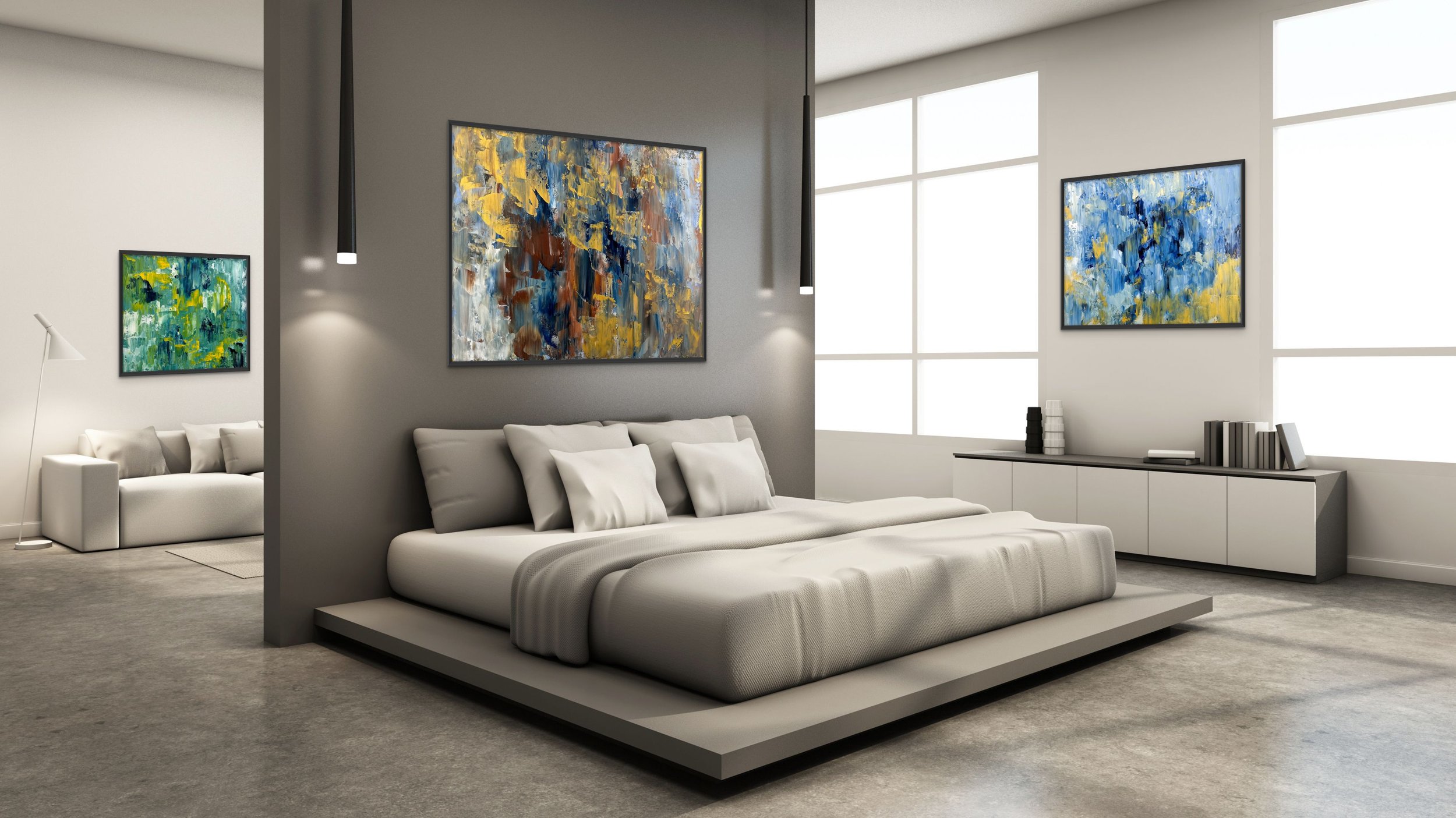
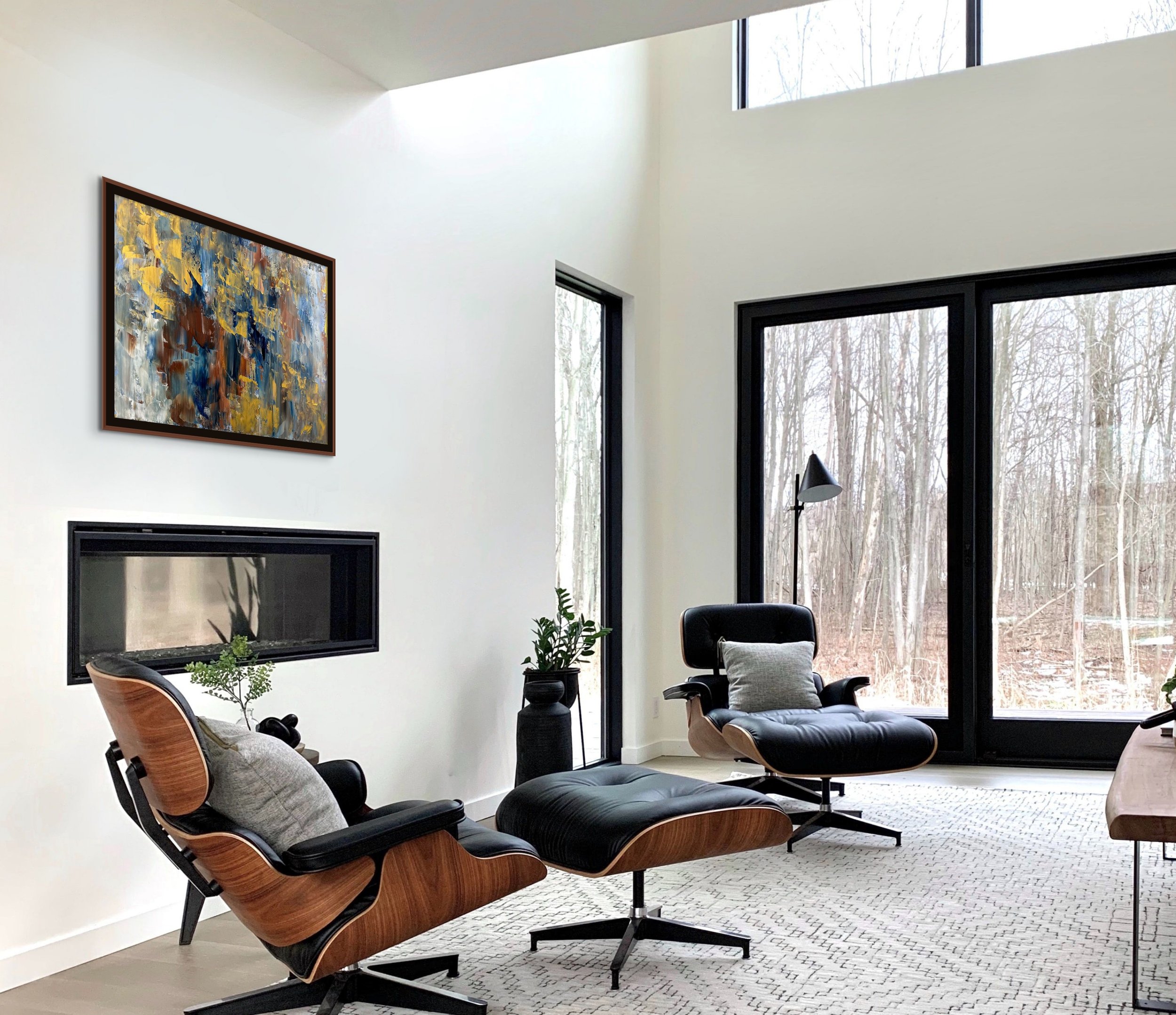
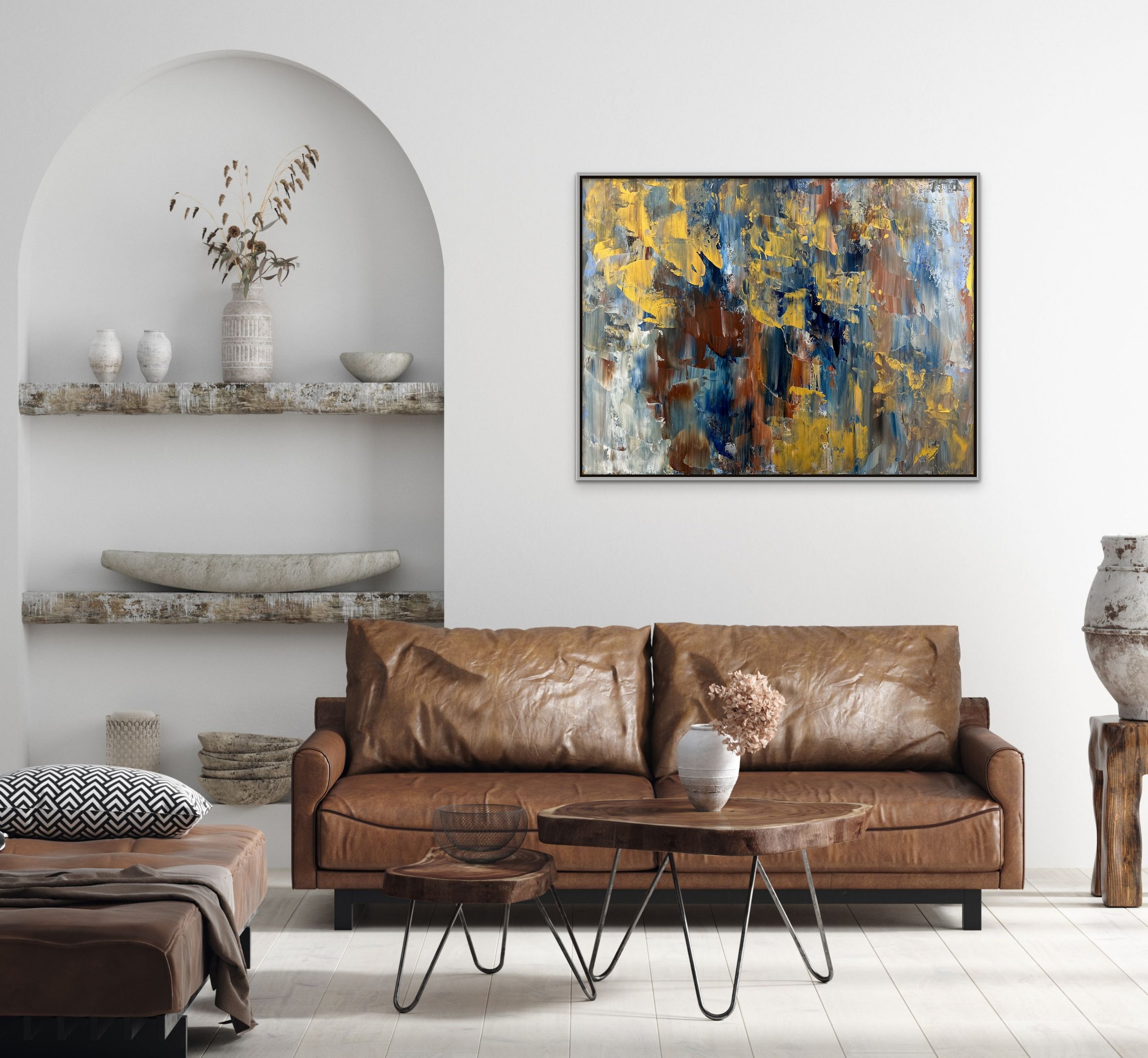
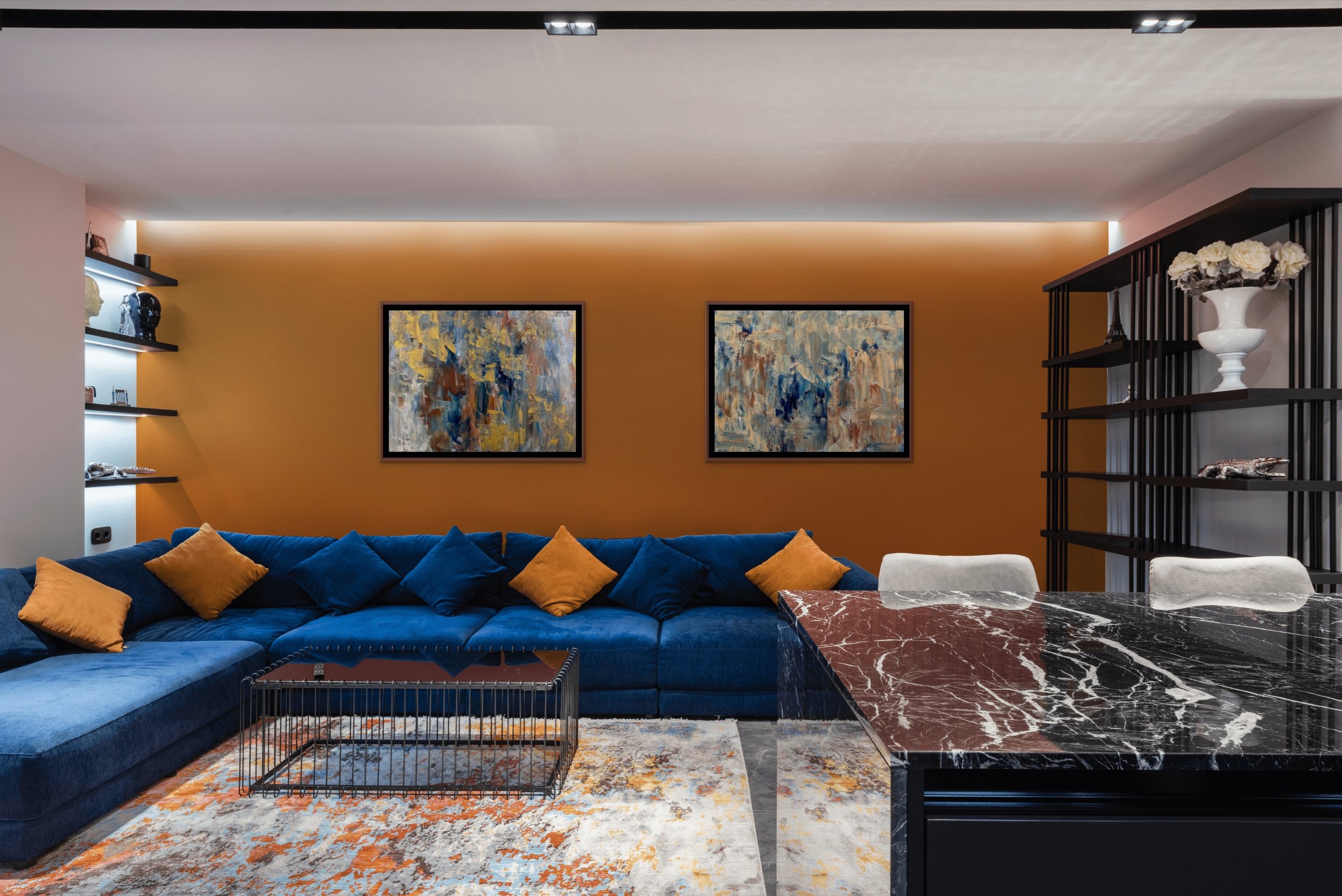

Take a peek inside my new book, 100 Days Of Happy Happy Art, Evidence-Based Design.
There’s even a chapter on neuroscience and art.
Did You Know This About Health And Art?
Did you know that Evidence-Based Design nature scenes are restorative?
Did you know that Evidence-Based Design nature scenes are restorative?
With all the talk today about Evidence-Based Design—what is it?
Evidence-Based Design is a field of study that emphasizes using credible medical and scientific evidence to influence design. Evidence-Based Design uses ideas from environmental psychology, architecture, neuroscience, behavioral economics, and more.
According to Ulrich and Gilpin, research suggests that nature art, or art with views or representations of nature will promote restoration if it contains—
calm or slowly moving water
verdant foliage
flowers
spatial openness
park-like settings or Savannah-like properties
Over the years, I have tried to create location appropriate art using these (and other) evidence-based design principles and guidelines.
Here are three paintings where the backgrounds are of a stretch of beach on Highway 23 in Northern Michigan. (Local scenes are also favored in evidence-based design.) I’ve taken some criticism over the years for not painting with enough tradition and realism. Even though I am a natural-born abstract artist who also creates evidence-based design art because it has the potential to help restore human health and happiness, I don’t mind. The huge pink clouds next to the pretty blue skies are in this first painting because that’s just how amazing the skies can be in this geographic location. (evidence-based design guideline: local scenery)
Print of Morning Majesty
Also, keeping in line with Ulrich and Gilpin’s evidence-based guideline of calm or slowly moving water, Lake Huron is amazingly still on most warm weather days. I deliberately keep my brushstrokes long and flowing. This creates the calmness, which creates a restorative/de-stressing effect. For water high-interest but not water high-focus, I blend the paint into a variety of colors.
People are often so surprised when they arrive at this location on Highway 23 because—from the horizon line to the shore—the water is often a dark blue, then medium blue, then a lighter blue, then an aqua color. The aqua color comes from an abundance of limestone. (evidence-based design: calm or slowly moving water)
Print of Beautiful And Happy
Print of Lake Huron Lovely #2
In many of these paintings, I also introduce the evidence-based guidelines of flowers and verdant foliage because people in this area love flowers. (evidence-based design: flowers and verdant foliage)
In the warmer months, many towns in the Great Lakes region burst with downtown flower festivals, downtown flower baskets, and flower sales.
This area, already a water lovers destination, also becomes a super happy flower lovers paradise.
This painting, Hope’s Sunshine, is a view of Lake Huron from flower-beautiful Mackinac Island
Take a peek inside my new book, 100 Days Of Happy Happy Art, Evidence-Based Design
There’s even a chapter on neuroscience and art.
Did You Know This About Health And Art?
Did you know there is now scientific evidence showing that art heals?
Did you know there is now scientific evidence that art heals?
That’s right. There is now clear and convincing medical evidence that viewing nature inspired compositions plays a key role in creating healing environments for us.
Certain types of art even have the power to—
reduce stress
lower blood pressure
reduce the need for pain medication
be a positive distraction
and more
As an evidence-based design (EDAC) certified artist, I like to read scientific and medical study findings and translate them into works of art.
One way I do this is through my floral designs. Each painting in this category is deliberately and strategically designed to meet one or more evidence-based design standards and guidelines.
My goal for these florals is never to create just a pretty work of art. That’s a given.
My goal is to create art that triggers the brain to create uplifting feelings of happiness and joy. The reaction I look for is not, “Oh, that’s pretty!” The reaction I want to hear as an evidence-based design artist is, “Yes, there’s something about this painting that makes me feel good as I look at it.”
Soft and simple, this evidence-based design sold as soon as it was put on display.
This evidence-based design also sold as soon as it was put on display.
Different aspects of these paintings were considered before painting. Which background color would be upbeat? How should the stems form to show joy and happiness? Where would the dividing lines be between the composition’s interest levels and stress levels? How would fun and happiness be communicated throughout the work of art?
Joy by Dorothea Sandra

